 "ttyymmnn" (ttyymmnn)
"ttyymmnn" (ttyymmnn)
05/28/2019 at 12:35 • Filed to: wingspan, planelopnik history, Planelopnik
 10
10
 32
32
 "ttyymmnn" (ttyymmnn)
"ttyymmnn" (ttyymmnn)
05/28/2019 at 12:35 • Filed to: wingspan, planelopnik history, Planelopnik |  10 10
|  32 32 |
!!! UNKNOWN CONTENT TYPE !!!
Welcome to
This Date in Aviation History
, getting of you caught up on milestones, important historical events and people in aviation from May 25 through May 28.
!!! UNKNOWN CONTENT TYPE !!!
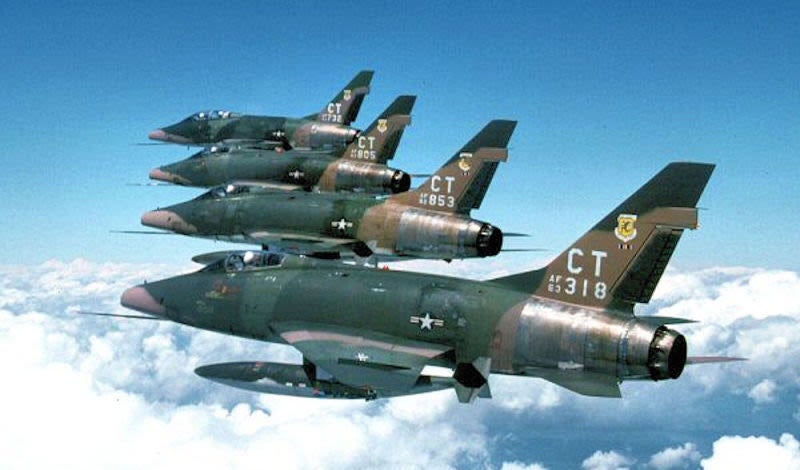
A formation of F-100D Super Sabres of the 118th Tactical Fighter Wing in Vietnam-era jungle camouflage in 1961 (US Air Force)
May 25, 1953 – The first flight of the North American F-100 Super Sabre. The 1950s was an extraordinary period for fighter aircraft development. The piston engine of WWII had largely given way to the new turbojet engine, and straight wings had transitioned to swept wings that offered higher speeds and less drag. But perhaps more than anything, the 1950s was an era notable for the quest for ever greater speeds. Fighters had already broken the sound barrier in short bursts of speed, but the US Air Force was looking for a fighter that could fly at sustained supersonic speeds. North American had made a solid reputation for itself in WWII with the remarkable !!!error: Indecipherable SUB-paragraph formatting!!! , and they followed up the success of the Mustang with the swept-wing !!!error: Indecipherable SUB-paragraph formatting!!! , which proved its mettle in the skies over Korea during the Korean War and found a place in the pantheon of the greatest warplanes. For their next world-beater, North American turned to the F-86 as a basis for the design of an even more powerful fighter.
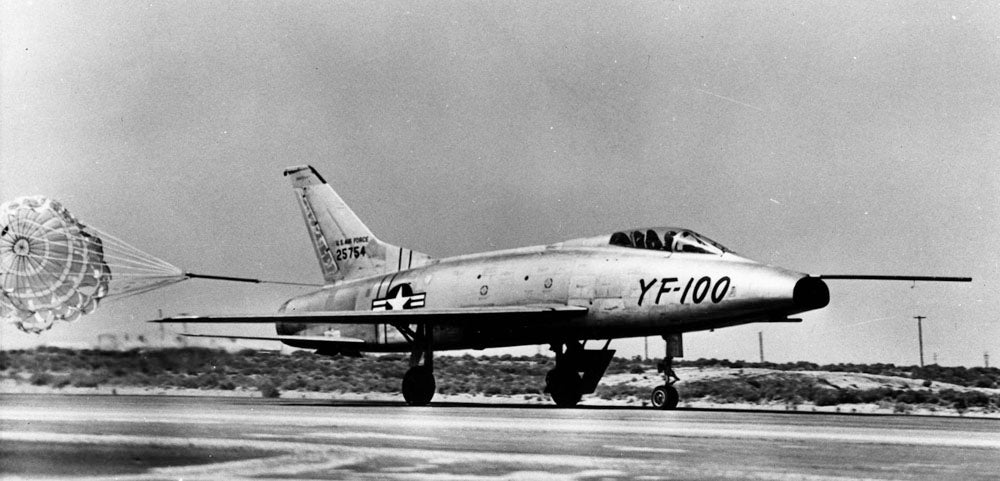
The North American YF-100, the prototype for the F-100 Super Sabre, deploys a braking parachute on landing (US Air Force)
Work on the F-100 began in 1951 with a company-funded aircraft called the Sabre 45, a designation that came from the aircraft’s 45-degree wing sweep (the F-86 employed 35 degrees of sweep). Though much more powerful and more streamlined, the F-100 still shared its predecessor’s nose air intake and single engine, though the Super Sabre used a !!!error: Indecipherable SUB-paragraph formatting!!! engine which delivered nearly twice the power than the F-86's J47. The Super Sabre also made far more use of titanium in its construction, a metal known for both lightness and strength. The first prototype Super Sabre reached Mach 1.07 on its first flight, even though it was fitted with a purposefully de-rated engine. Due to delays in production of the !!!error: Indecipherable SUB-paragraph formatting!!! , the Air Force accepted the Super Sabre immediately in 1953, and delivery to Air Force squadrons began in 1954.
However, the Super Sabre began to show worrying handling characteristics, and a series of crashes caused the fleet to be grounded in November 1954. Flight tests showed that, during roll maneuvers, the F-100 had a nasty inclination to pitch up and down simultaneously, and the highly-swept wings made the Super Sabre susceptible to pitch up at low speeds, something that pilots referred to as the “ !!!error: Indecipherable SUB-paragraph formatting!!! .” Engineers corrected these problems by enlarging the vertical stabilizer by 27-percent, while also increasing the wingspan by 26 inches. With the control problems solved, deliveries of the Super Sabre restarted and existing aircraft were returned to flying status. But even as the redesigned F-100A began returning to duty, the Air Force began phasing the “Hun” out of service, and it was officially removed from active service by 1961. But that wasn’t the end of the Super Sabre. With Cold War tensions rising in Eastern Europe, the F-100 returned to active duty while North American worked to develop a fighter-bomber version, which became the F-100C. This variant had a still more powerful engine and was developed for nuclear !!!error: Indecipherable SUB-paragraph formatting!!! .
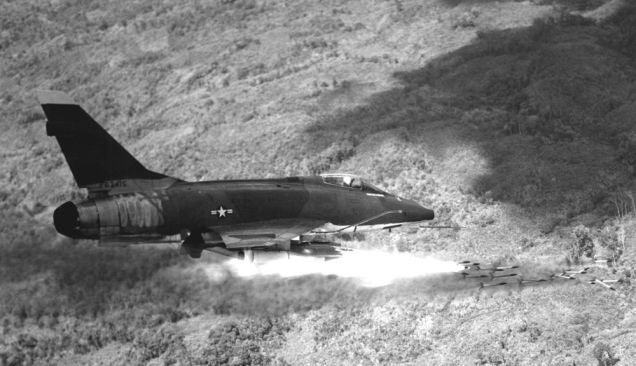
A US Air Force F-100D Super Sabre launches rockets against ground targets in Vietnam (US Air Force)
But it was the F-100D that served in the greatest numbers and with the greatest effect. The Super Sabre went to war in Vietnam in 1961 and served for 10 years, becoming the longest serving fighter bomber of the conflict. At the end of the war, Huns had fired over four million rounds of 20mm ammunition, dropped 30 million pounds of bombs, and delivered over 10 million pounds of napalm. Two-seat F-100F Super Sabres served as forward air controllers, flew reconnaissance missions, and carried out search and rescue missions. In a testament to its incredible speed, the Super Sabre set numerous speed records and won the !!!error: Indecipherable SUB-paragraph formatting!!! in 1955. It was also the first jet fighter to fly over the North Pole, and was flown by the !!!error: Indecipherable SUB-paragraph formatting!!! from 1956 to 1968. Just under 2,300 Super Sabres were produced, and it was retired from frontline service in 1979, though it continued serving with Air National Guard units until 1988.
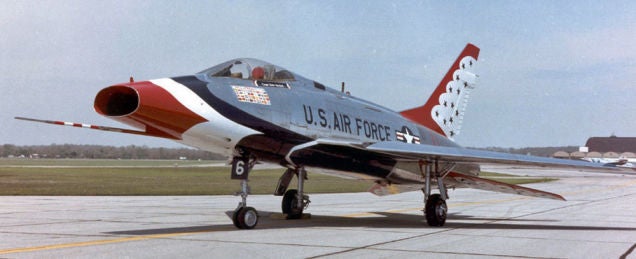
An F-100D Super Sabre of the US Air Force Thunderbirds flight demonstration team (US Air Force)
!!! UNKNOWN CONTENT TYPE !!!
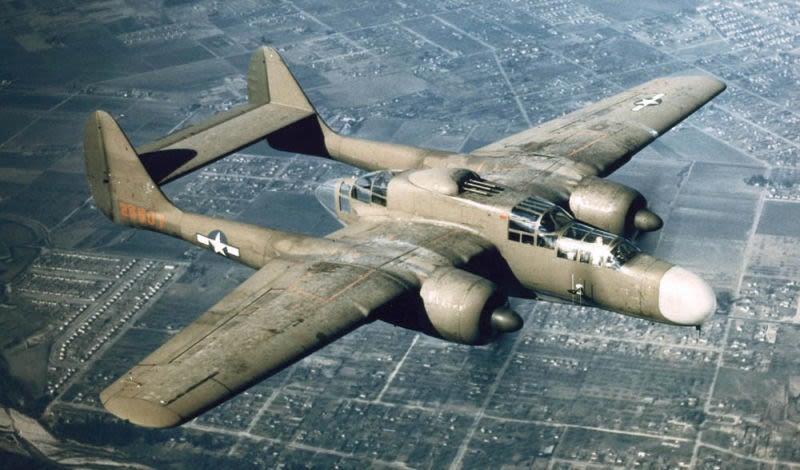
A P-61A painted in US Army Air Forces green some time in the 1940s (US Air Force)
May 26, 1942 – The first flight of the Northrop XP-61 Black Widow. In modern times, it’s difficult or even impossible to imagine a fighter without a radar. Powerful modern radars have made possible fighters that can fly in all weather conditions, day or night, and attack enemy targets that are even beyond the pilot’s range of sight. But during WWII, the roles of day fighter and night fighter were, for the most part, separate. Smaller, more agile fighters fought by day, while larger aircraft capable of carrying the early heavy radar sets fought by night. British development of radar (an acronym coined by the United States Navy for “radio detection and ranging”) had been progressing steadily since the early days of the war, and land-based radar stations proved vital during the !!!error: Indecipherable SUB-paragraph formatting!!! in detecting incoming German bombers and directing RAF fighters to intercept them. By late summer of 1940, the British finally developed an airborne radar unit, called the Airborne Intercept (AI) radar, but they didn’t have an aircraft that could carry it.
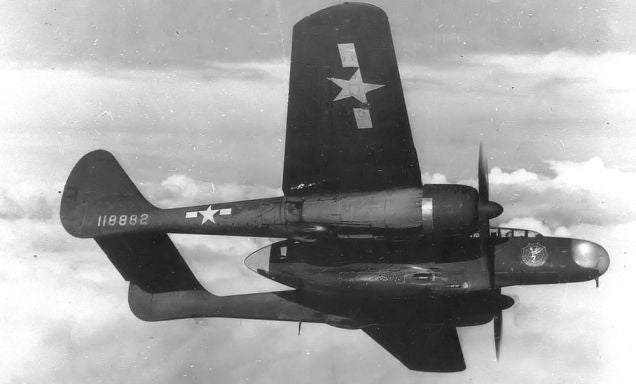
Northrop YP-61 pre-production prototype from the 348th Night Fighter Squadron, showing the blisters beneath for fuselage for its 20mm cannons. The radar is housed in the unpainted nose section. (US Air Force)
The obtain an effective night fighter, the RAF requested aircraft designs from every Allied manufacturer, one of which was Northrop. Jack Northrop understood that any aircraft capable of the speed, altitude, range and firepower that the RAF requested, along with the ability to carry the heavy radar, needed to be big and would require more than one engine. While work on the airborne radar was progressing in England, the British !!!error: Indecipherable SUB-paragraph formatting!!! came to the US to receive assistance in developing new technologies away from the danger of German bombing, and they brought their AI radar with them. With the exchange of technologies, the US saw the potential for making their own night fighter, and the Army made a formal request for such an aircraft. With the head start Northrop had from working on the British proposal, the new XP-61 beat out the only competitor for the contract, the Douglas XA-26A, a night-fighter based on the !!!error: Indecipherable SUB-paragraph formatting!!! .
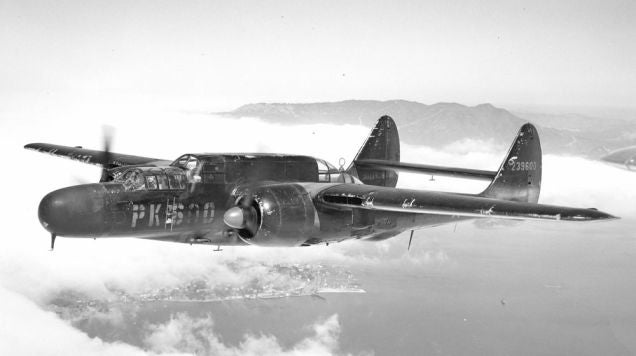 !!!CAPTION ERROR: MAY BE MULTI-LINE OR CONTAIN LINK!!!
!!!CAPTION ERROR: MAY BE MULTI-LINE OR CONTAIN LINK!!!
Northrop’s design placed a large gondola between twin booms that each housed an 18-cylinder !!!error: Indecipherable SUB-paragraph formatting!!! radial engine. Based on the original British request, the gondola housed two machine gun turrets, one in the nose and one in the rear, each with four guns. Eventually, the rear turret was replaced with a powered turret on the top of the fuselage, though buffeting from the turret eventually led to its removal all together. Northrop then finalized the design by placing four 20mm cannons in the belly of the aircraft, making the Black Widow one of the few American aircraft to mount four cannons.
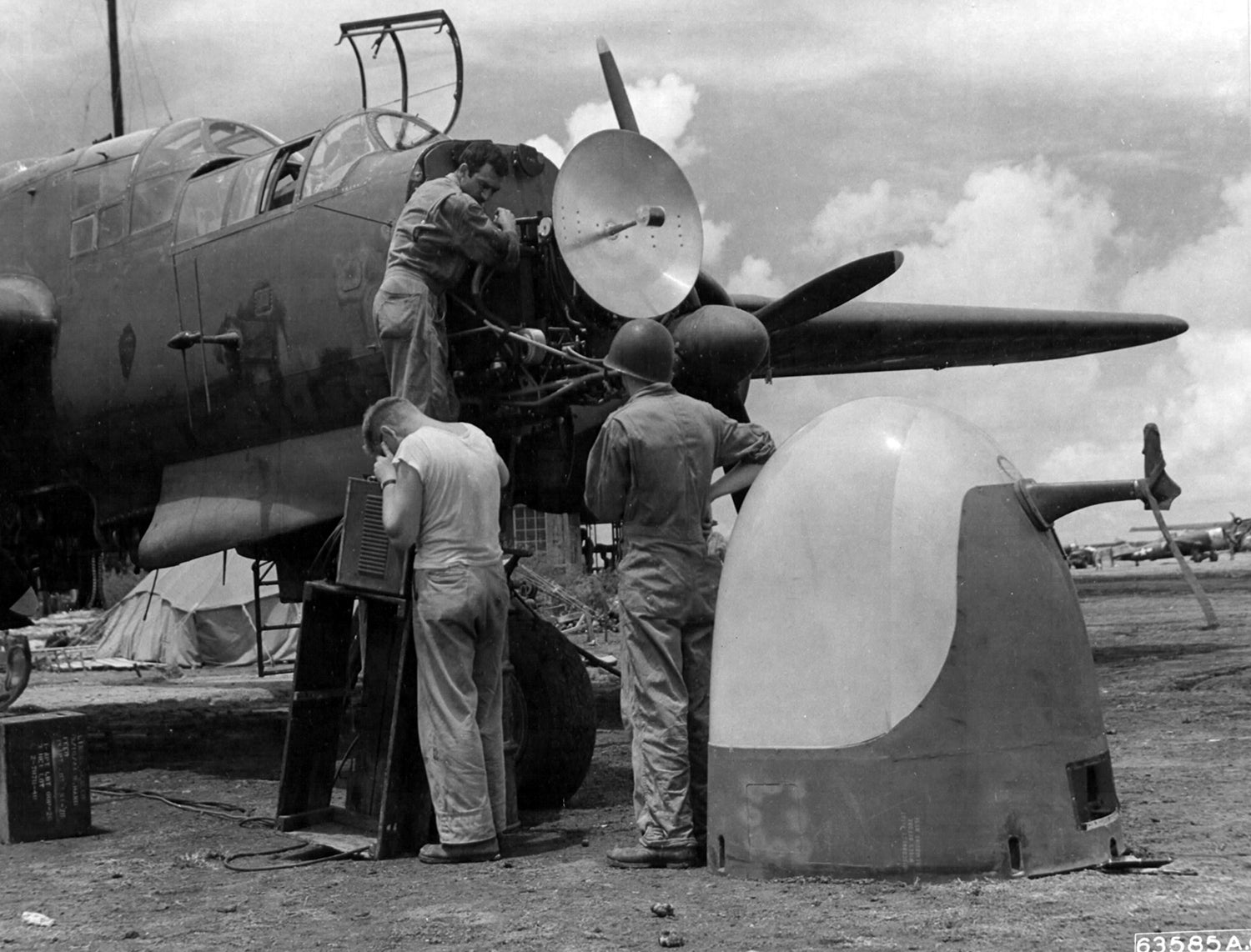
The SCR-720 radar unit mounted to a P-61 Black Widow of the 6th Night Fighter Squadron undergoes maintenance on Saipan some time in 1945 (US Air Force)
Though history notes the Black Widow as America’s first dedicated night fighter, it was difficult, by the standards of contemporary fighter design, to call the Black Widow a fighter. It was a true behemoth, with a wingspan of 60 feet (8 feet longer than the !!!error: Indecipherable SUB-paragraph formatting!!! ), a height of nearly 15 feet, and an empty weight of over 23,000 pounds. When Black Widows arrived in Europe in the spring of 1944, Army commanders were convinced that the P-61 was too slow and cumbersome to counter German aircraft. Instead, they wanted to procure the British !!!error: Indecipherable SUB-paragraph formatting!!! , and even went so far as to organize a competition between the two aircraft. However, with a few tweaks to the engine to improve performance, the Black Widow was able to outperform the Mossie in speed and rate of climb and, with its special “ !!!error: Indecipherable SUB-paragraph formatting!!! ” and retractable spoilers, the P-61 could even outmaneuver the Mosquito. While still unable to outduel German single-engine fighters, the Black Widow proved quite effective against German bombers and fighter-bombers. P-61 squadrons even claimed a number of German !!!error: Indecipherable SUB-paragraph formatting!!! flying bombs. In the Pacific, the Black Widow arrived too late to have a significant impact on the war, but it did play a vital role in the !!!error: Indecipherable SUB-paragraph formatting!!! of over 500 Allied prisoners from the Cabanatuan prison camp in the Philippines. Though it never fired a shot, a lone P-61 performed aerobatics over the camp to distract Japanese guards while Army Rangers positioned themselves for an assault. A Black Widow is also unofficially credited with scoring the last aerial victory of WWII.
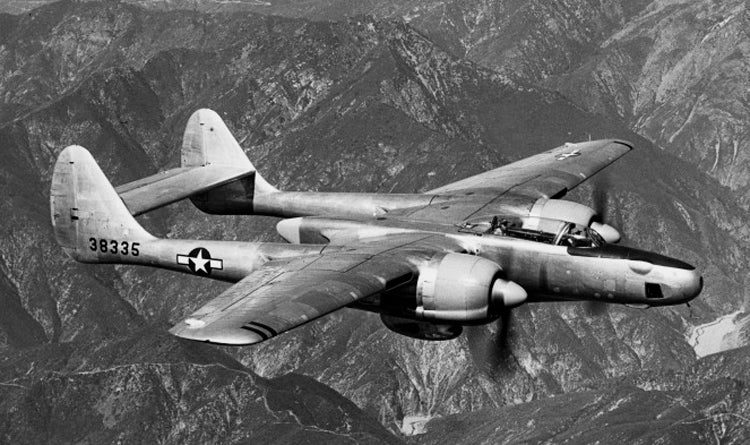
The Northrop F-15 Reporter, the reconnaissance variant of the P-61. Note the redesigned center section, and the portholes in the nose for photography. (San Diego Air and Space Museum)
While many WWII aircraft were retired quickly at the end of the war, the Black Widow, as America’s only night fighter, soldiered on until the US produced a jet-powered alternative, which eventually came in the form of the !!!error: Indecipherable SUB-paragraph formatting!!! . In addition to their combat duties, P-61s also played a leading role in research into ejection seat technology, carried out tests on !!!error: Indecipherable SUB-paragraph formatting!!! engines, and took part in the !!!error: Indecipherable SUB-paragraph formatting!!! , America’s first large-scale scientific study of thunderstorms. Northrop also developed a reconnaissance variant called the !!!error: Indecipherable SUB-paragraph formatting!!! , which removed the top portion of the central gondola and housed the two-man crew under a single canopy. While the final flight of the P-61 was made in 1954, the Reporter served in various roles until 1968.
!!! UNKNOWN CONTENT TYPE !!!
!!! UNKNOWN CONTENT TYPE !!!
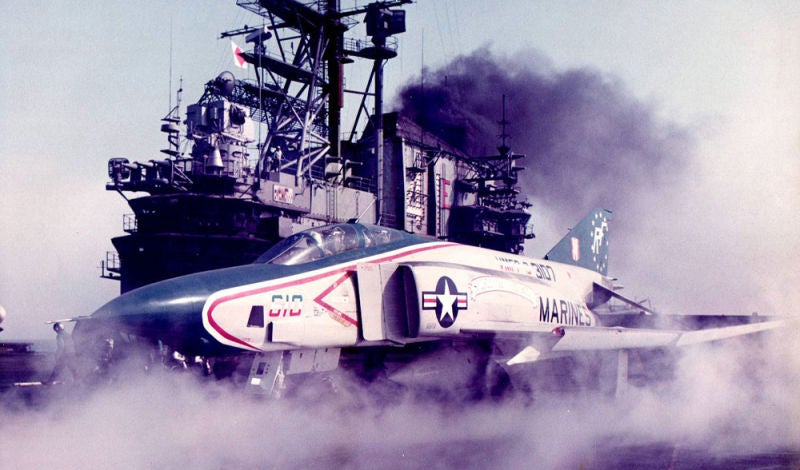 !!!CAPTION ERROR: MAY BE MULTI-LINE OR CONTAIN LINK!!!
!!!CAPTION ERROR: MAY BE MULTI-LINE OR CONTAIN LINK!!!
May 27, 1958 – The first flight of the McDonnell Douglas F-4 Phantom II. In our modern military, the multi-role fighter aircraft has become the mainstay of the US Navy, Air Force and Marine Corps. During WWII, specialized aircraft had taken on their individual missions, but the 1950s saw a move to aircraft that could be equally effective in the roles of ground attack, air superiority and, for the Navy, fleet defense. But with the adoption of multi-role aircraft came a significant increase in size, complexity, and cost.
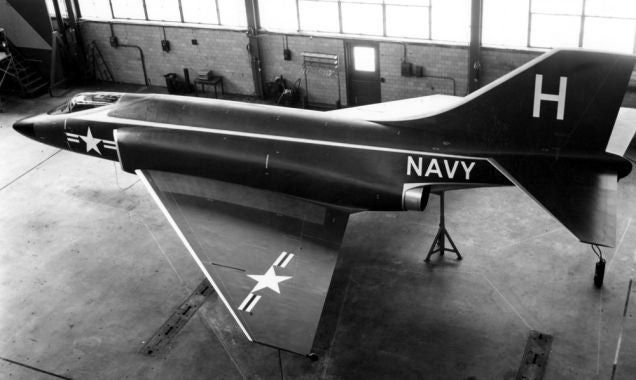
The mockup of the McDonnell F3H-G, which formed the basis for the F4H Phantom II. Note the completely horizontal wingtips and tailplane. (US Navy)
As the Korean War drew to a close, McDonnell Douglas began an internal project to develop a new fighter that they hoped would be of interest to the US Navy. Starting with the F3H Demon, McDonnell worked to develop a so-called Super Demon, which would be powered by a pair of !!!error: Indecipherable SUB-paragraph formatting!!! axial-flow turbojets which promised a top speed approaching Mach 2. The program progressed as far as a mockup before the Navy decided that they already had supersonic day fighters under development with the !!!error: Indecipherable SUB-paragraph formatting!!! and the !!!error: Indecipherable SUB-paragraph formatting!!! , both of which could adequately cover their need for a supersonic fighter. Though the Tiger and Crusader were effective fighters, McDonnell set to work on developing their Super Demon concept into an all-weather fighter and bomber. But when the Navy saw the progress on the new fighter, they then asked McDonnell for a fleet defense interceptor with a radar that required a second crewman. Not only was the Phantom growing in size, it was also gaining complexity.
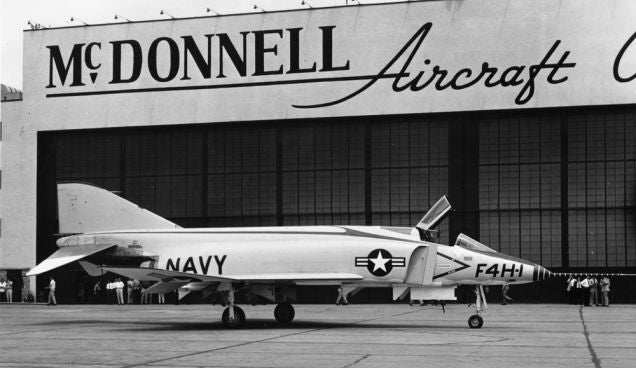
The F4H-1 Phantom II prototype. Note location for the second pilot, and its limited visibility. This position was known as “the hole.” (US Navy)
McDonnell’s initial offering needed some redesigning, and the result was the odd assortment of competing up and down wing angles that made the Phantom instantly recognizable. Wind tunnel testing indicated an instability that could be cured most effectively by a 5-degree dihedral (upward sweep) to the wings. However, changing the design at this point in the Phantom’s development would require a complete redesign of the titanium central section at a significant cost of time and money. So McDonnell engineers gave just the wingtips a 12-degree dihedral, and the Phantom’s iconic upswept wingtips were born. The Phantom also received another one of its characteristic features, the anhedral (downswept) elevators. These were declined at 23-degrees to improve handling at high angles of attack. For the interceptor role, the Phantom needed a powerful radar, as well as a second crewman to operate it. In the early Phantoms, the rear seat was occupied by a pilot sitting “in the hole,” but later variants replaced the pilot with a radar intercept officer (RIO). Once the Navy accepted the new fighter, it was given the designation F4H-1, and McDonnell delivered 45 of these aircraft, essentially pre-production Phantoms that were !!!error: Indecipherable SUB-paragraph formatting!!! as the F-4A. The F-4A was followed by the F-4B, which was given upgraded J79 engines and a more powerful radar.
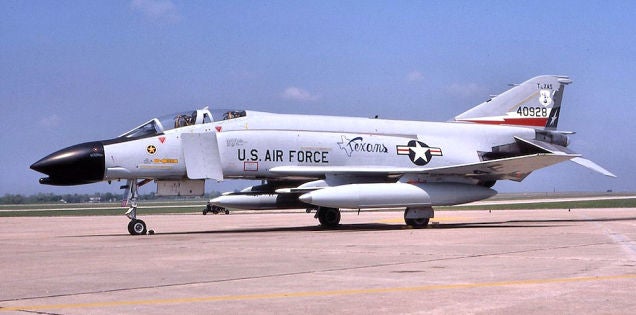
US Air Force F-4C Phantom II of the 111th Fighter Interceptor Squadron. (US Air Force)
By now, the US Air Force was showing interest in McDonnell’s new interceptor and, as part of Defense Secretary !!!error: Indecipherable SUB-paragraph formatting!!! push to have one fighter serve all the flying branches of the military, the Air Force took 29 aircraft on loan from the Navy before eventually ordering their own. Initially, the Air Force designated the aircraft as the F-110A Spectre, but finally settled on calling it the F-4C. With the Air Force’s adoption of the Phantom, it marked the first time that all three fixed-wing aviation branches of the US military—Air Force, Navy, Marine Corps—flew the same fighter. In a relatively short time, the Phantom began setting records for speed and altitude, and eventually garnered 16 world records, all of them set in unmodified production aircraft.
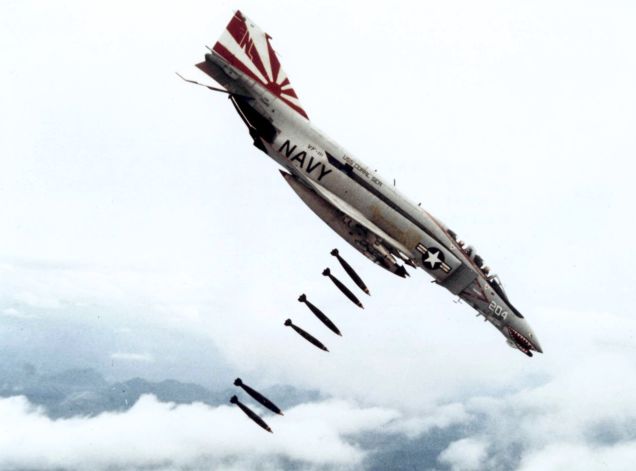
An F-4B Phantom II of US Navy Fighter Squadron VF-111 “Sundowners” on a bombing mission over Vietnam in 1971. (US Navy)
The Phantom was soon fighting in the skies over Vietnam, where it became the principal ground attack aircraft and air superiority fighter, with pilots or RIOs of both the Navy and Air Force becoming aces flying the F-4. But despite these victories, the Phantom was hampered by its reliance on guided missiles in combat. When the Phantom was initially designed, the Air Force felt that the age of the gun given way to the age of the missile, and the Phantom did not have an internal gun for close range engagements. To make matters worse, early missiles were unreliable, and often failed to hit their targets. This shortcoming was eventually addressed by the addition of a rotary cannon mounted in a pod underneath the fuselage, though it proved difficult to use in combat, and the F-4E was finally fitted with an internal gun.
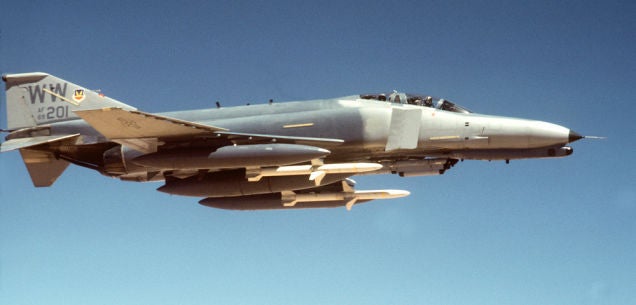
An F-4G “Wild Weasel” from the US Air Force 35th Tactical Fighter Wing armed with AGM-88 high speed anti-radiation missies flies over the Saudi desert Operation Desert Shield in January 1991. (US Air Force)
In addition to its fighter and attack duties, the F-4 proved to be an excellent reconnaissance aircraft as the RF-4, and was also developed into an electronic warfare variant known as the F-4G !!!error: Indecipherable SUB-paragraph formatting!!! , both of which served long enough to see action in the !!!error: Indecipherable SUB-paragraph formatting!!! of 1990 before being retired for good in 1996. Many of the remaining F-4s ended their life as QF-4 target drones. The Phantom was widely exported, and a handful of nations still operate the Phantom to this day. By the time production ended in 1981, McDonnell had delivered just under 5,200 Phantoms.
!!! UNKNOWN CONTENT TYPE !!!
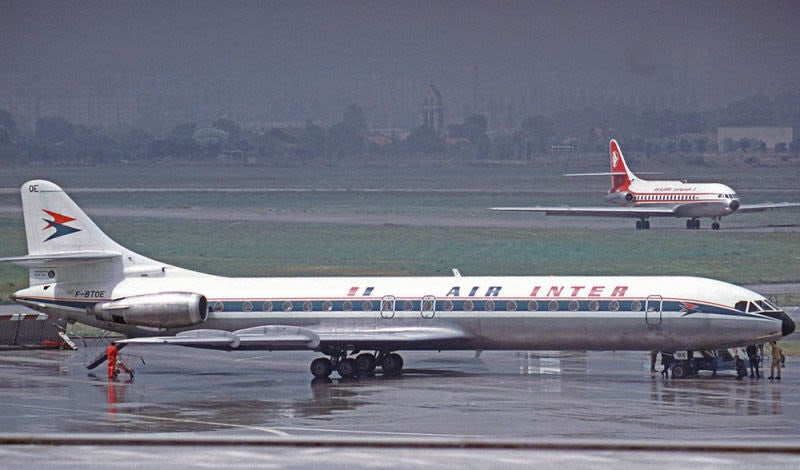 !!!CAPTION ERROR: MAY BE MULTI-LINE OR CONTAIN LINK!!!
!!!CAPTION ERROR: MAY BE MULTI-LINE OR CONTAIN LINK!!!
May 27, 1955 – The first flight of the Sud Aviation Caravelle. Following the maiden flight of the !!!error: Indecipherable SUB-paragraph formatting!!! in 1949, commercial air travel officially entered the Jet Age. Though the Comet was a relatively large aircraft by the standards of its day, its early configurations carried only 36 passengers, due in part to very few seats being placed in the spacious cabin—a luxury by today’s standards. But soon after its introduction, the Comet suffered a series of high profile crashes whose cause was eventually traced to metal fatigue at the corners of its square windows, and the revolutionary airliner was removed from service until the windows could be redesigned. The aviation industry was ripe for a challenger to the Comet, and the Sud Aviation Caravelle was waiting in the wings.
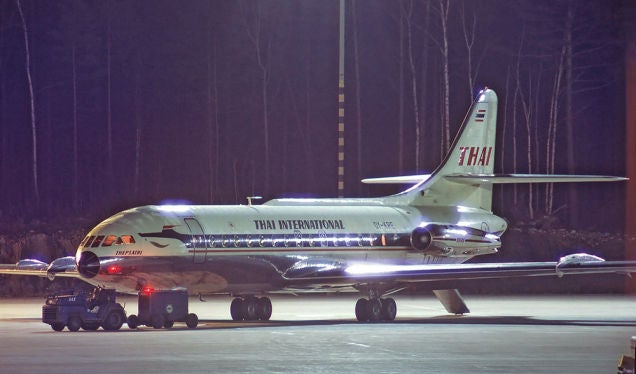 !!!CAPTION ERROR: MAY BE MULTI-LINE OR CONTAIN LINK!!!
!!!CAPTION ERROR: MAY BE MULTI-LINE OR CONTAIN LINK!!!
In 1951, a year before the Comet entered service, the French Comité du matériel civil (civil aircraft committee) announced specifications for a new medium-range airliner that could accommodate 55-65 passengers, have a cruising speed of 370 mph, and a range of 1,200 miles, though they did not specify the type or number of engines to be used. They received no less that 20 proposals of varying designs, most of which employed the new turbojets that were coming into use at the time. By March 1952, the committee had winnowed the list down to three entrants, one of which was a proposal by !!!error: Indecipherable SUB-paragraph formatting!!! , better known as Sud-Est or SNCASE. The SNCASE design was originally powered by three engines, but with the arrival of more powerful !!!error: Indecipherable SUB-paragraph formatting!!! engines it became clear that two engines would be sufficient and the tail-mounted engine was removed. The remaining engines were left on the rear fuselage rather than moved to the wing, an arrangement that had the added benefit of making the passenger cabin quieter during flight.
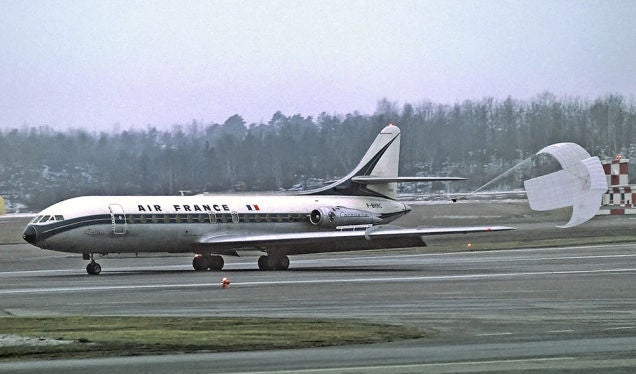 !!!CAPTION ERROR: MAY BE MULTI-LINE OR CONTAIN LINK!!!
!!!CAPTION ERROR: MAY BE MULTI-LINE OR CONTAIN LINK!!!
The nose section of the Caravelle was a direct copy of that of the Comet, which Sud licensed from de Havilland. After the experience of the square windows in the Comet, the Caravelle received its distinctive teardrop shaped windows, which maintained the strength of the fuselage while also allowing passengers to look downward. The lack of engine pods under the wing resulted in an aerodynamically clean wing, which SNCASE gave a 20-degree sweep. Unwittingly, the Sud designers had created the template for almost all future rear-engined aircraft to come. Air France placed the first orders for the new airliner in 1956, followed by SAS a year later, and the Caravelle entered service with both carriers in 1959.
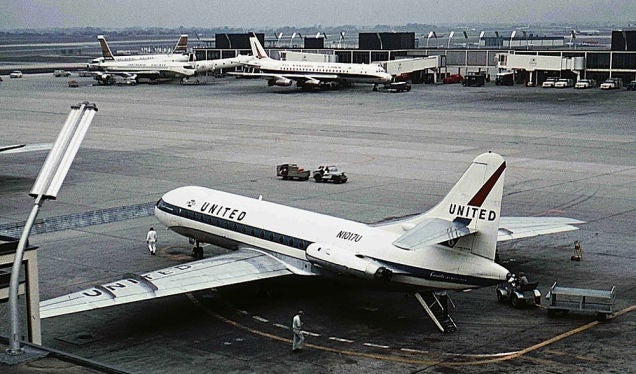 !!!CAPTION ERROR: MAY BE MULTI-LINE OR CONTAIN LINK!!!
!!!CAPTION ERROR: MAY BE MULTI-LINE OR CONTAIN LINK!!!
The Caravelle became an instant success, and eventually served air carriers in 47 nations, as well as the militaries and governments of 12 nations. United Airlines was the sole US operator of the Caravelle when it purchased 20 airliners which entered service in 1961. As the Caravelle became more and more popular, !!!error: Indecipherable SUB-paragraph formatting!!! (as it became known following the merger of Sud-Est and Sud-Ouest in 1957) continued development of the airliner with eight variants following the original production model, mostly with improved engines. By the sixth variant, the Caravelle 10R, the Rolls-Royce turbojets gave way to !!!error: Indecipherable SUB-paragraph formatting!!! low-bypass turbofan engines, the same ones used on the comparable !!!error: Indecipherable SUB-paragraph formatting!!! and larger !!!error: Indecipherable SUB-paragraph formatting!!! . By the final variant, the Caravelle 12, the length of the fuselage had been stretched thirteen feet and passenger capacity had grown to 140. A total of 282 Caravelles were produced between 1958-1972, and the last was retired in 2005.
!!! UNKNOWN CONTENT TYPE !!!
Short Takeoff
!!! UNKNOWN CONTENT TYPE !!!
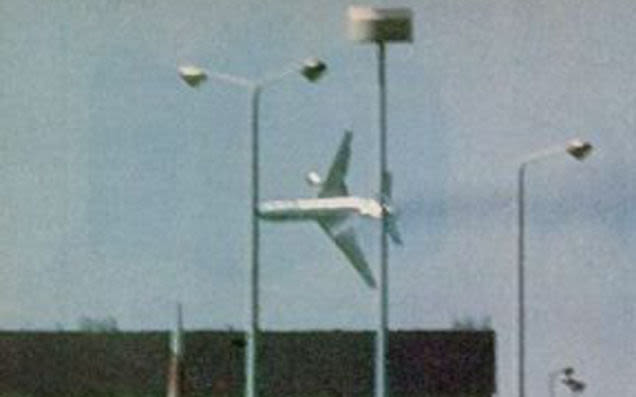
(Michael Laughlin)
May 25, 1979 – The crash of American Airlines Flight 191, a regularly scheduled flight from Chicago O’Hare International Airport to Los Angeles International Airport. The wide body airliner crashed shortly after takeoff when the left engine of the !!!error: Indecipherable SUB-paragraph formatting!!! (N110AA) separated from the wing, severing hydraulic lines, damaging the left wing’s leading edge, and causing an uncommanded retraction of the leading edge slats. As the aircraft continued to takeoff, the unbalanced configuration of the wing slats caused the left wing to stall while the right wing was still providing lift, and the aircraft rolled to the left until partially inverted before crashing in a nearby field. The crash killed all 271 passengers and crew as well as two people on the ground. It remains the deadliest aviation accident on US soil. The engine separation was found to have been caused by faulty maintenance practices performed by American Airlines, and not a design defect. As a result, American Airlines was fined $500,000 for improper maintenance procedures.
!!! UNKNOWN CONTENT TYPE !!!
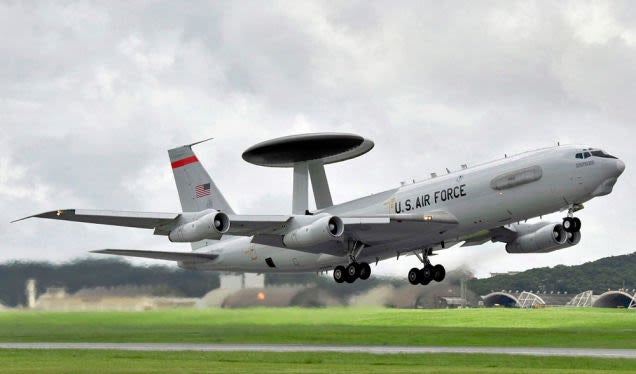
(US Air Force)
May 25, 1976 – The first flight of the Boeing E-3 Sentry, an !!!error: Indecipherable SUB-paragraph formatting!!! (AEWC) aircraft more commonly known as AWACS that was developed to replace the !!!error: Indecipherable SUB-paragraph formatting!!! . The E-3 was derived from the civilian !!!error: Indecipherable SUB-paragraph formatting!!! airliner and uses its dorsal radome and other sensors to monitor the battlefield and the airspace around it. The Sentry then provides enhanced situational awareness to battlefield commanders, and helps control air and ground forces necessary for interdiction, reconnaissance, airlift and close air support. The E-3 entered service with the US Air Force in 1977, and has since been adopted by NATO, the Royal Air Force and Saudi Arabia. Produced from 1977-1992, a total of 68 have been built and it remains operational.
!!! UNKNOWN CONTENT TYPE !!!
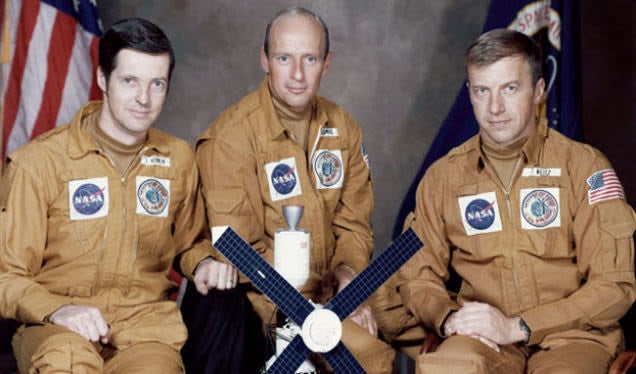
(NASA)
May 25, 1973 – The launch of Skylab 2, the first of three manned missions to !!!error: Indecipherable SUB-paragraph formatting!!! , the United States’ first orbital space station. The Skylab space station was launched on May 14, 1973 (Skylab 1) and remained in orbit for six years. Skylab 2 astronauts !!!error: Indecipherable SUB-paragraph formatting!!! , !!!error: Indecipherable SUB-paragraph formatting!!! and !!!error: Indecipherable SUB-paragraph formatting!!! were launched into orbit atop a !!!error: Indecipherable SUB-paragraph formatting!!! rocket and docked with the station on May 26. They remained onboard the station for 28 days and set a new record for spaceflight duration. The crew also set records for the greatest distance traveled and the greatest mass docked in space. A primary objective of the mission was to repair a jammed solar array on the station and to cover the station with a solar blanket that took the place of a heat shield damaged during launch. In addition to other repairs, the crew also carried out 392 hours of experiments. The Skylab 2 Command Module returned to Earth on June 22, 1973 and was recovered by the !!!error: Indecipherable SUB-paragraph formatting!!! (CV-14) near San Diego.
!!! UNKNOWN CONTENT TYPE !!!
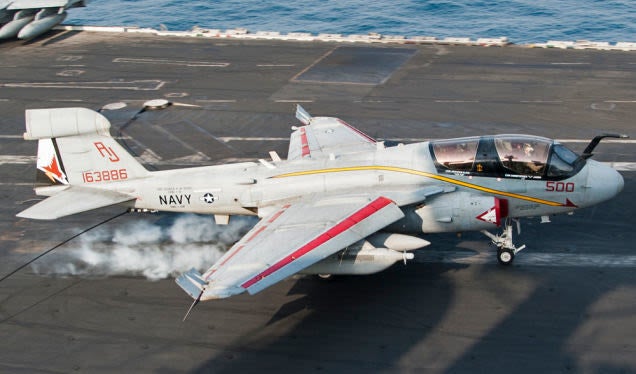
(US Navy)
May 25, 1968 – The first flight of the Northrop Grumman EA-6B Prowler. Following the success of the two-man !!!error: Indecipherable SUB-paragraph formatting!!! electronic warfare aircraft in Vietnam, Grumman stretched the aircraft’s fuselage to add a second row of seating for electronics warfare officers, added an antenna fairing to the vertical stabilizer, and placed more powerful radars in the nose to produce the EA-6B. Introduced in 1971, Prowlers replaced the !!!error: Indecipherable SUB-paragraph formatting!!! and flew 720 sorties in support of US Navy bombers and USAF !!!error: Indecipherable SUB-paragraph formatting!!! in Vietnam. The Prowler also served in Grenada, Afghanistan, Iraq and Syria and was retired from US Navy service in 2015 and replaced by the newer !!!error: Indecipherable SUB-paragraph formatting!!! . US Marine Corps Prowlers took part in bombing missions against the Syrian government in late 2018, and were retired in 2019.
!!! UNKNOWN CONTENT TYPE !!!
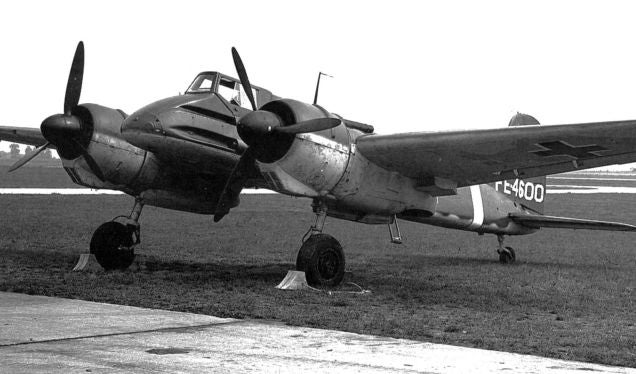
(US Air Force)
May 25, 1939 – The first flight of the Henschel 129, a twin-engine ground attack aircraft flown by the Luftwaffe during WWII. Based on experience of the German !!!error: Indecipherable SUB-paragraph formatting!!! in the Spanish Civil War, the 129 was developed to provide heavy fire against lightly defended targets such as convoys or troop concentrations. Because of its role as a ground attack aircraft, the pilot sat inside a tub of steel sheeting and was protected by armored glass, and the engines were also protected by armor. The 129 was powered by a pair of !!!error: Indecipherable SUB-paragraph formatting!!! radial engines because more powerful inline engines were in high demand elsewhere. Thus, the 129 was always underpowered and, when the two machine guns and two canons were replaced with a single 75mm antitank gun, the aircraft was virtually unflyable. Nevertheless, a total of 865 were produced from 1940-1944, and the 129 fought effectively in the early years of the war in North Africa and the Eastern Front.
!!! UNKNOWN CONTENT TYPE !!!
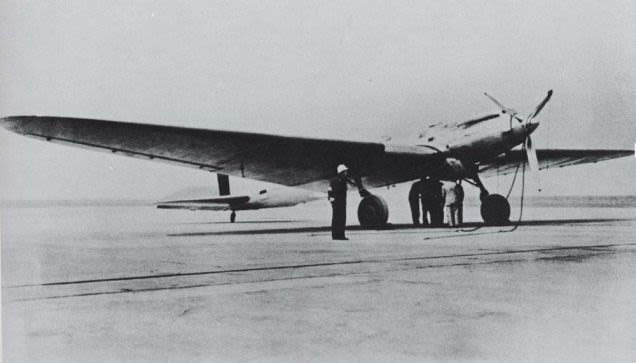
(Author unknown)
May 25, 1937 – The first flight of the Gasuden Koken,
a long-range research aircraft developed by the
!!!error: Indecipherable SUB-paragraph formatting!!!
(Gasuden) in an effort to break the world record for the longest closed circuit flight (taking off and landing from the same point). The plane was powered by a single Kawasaki V-12 engine that provided a top speed of 155 mph and had a wingspan of over 91 feet. The fuselage was constructed of metal, but the outer wings and control surfaces were covered in fabric. Following two unsuccessful attempts at the record, the Gasuden Koken took off from Kisarazu, Chiba on May 13, 1938 and made 29 laps of a 249-mile circuit. It landed two-and-a-half days later, having flown 7,239 miles, the only record ever set by Japan that was recognized by the
!!!error: Indecipherable SUB-paragraph formatting!!!
. The record was broken just one year later by an Italian
!!!error: Indecipherable SUB-paragraph formatting!!!
which flew 8,038 mi.
!!! UNKNOWN CONTENT TYPE !!!
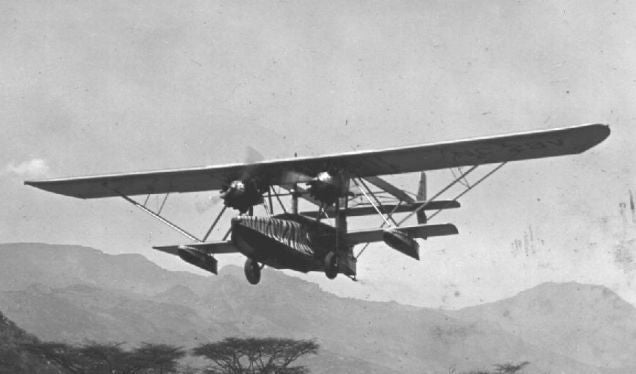 !!!CAPTION ERROR: MAY BE MULTI-LINE OR CONTAIN LINK!!!
!!!CAPTION ERROR: MAY BE MULTI-LINE OR CONTAIN LINK!!!
May 25, 1937 – The first flight of the Sikorsky S-38, a twin-engined amphibious !!!error: Indecipherable SUB-paragraph formatting!!! (a biplane in which one wing is significantly smaller than the other) that could accommodate eight passengers and was !!!error: Indecipherable SUB-paragraph formatting!!! first widely-produced flying boat. Developed from the !!!error: Indecipherable SUB-paragraph formatting!!! and !!!error: Indecipherable SUB-paragraph formatting!!! , both amphibious sesquiplanes that were built in very small numbers, the S-38 flew for Pan American Airways, the US Army, where it was known as the C-6, and the US Navy, where it was known as the PS-3. The S-38 was also popular with civilian pilots, and was popular with safari companies in Africa. Sikorsky built a total of 101 S-38s.
!!! UNKNOWN CONTENT TYPE !!!
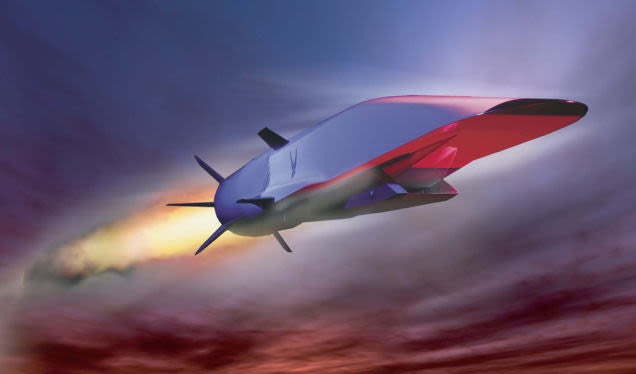
(US Air Force)
May 26, 2010 – The first flight of the Boeing X-51A WaveRider, an unmanned, !!!error: Indecipherable SUB-paragraph formatting!!! research aircraft that took its name from the !!!error: Indecipherable SUB-paragraph formatting!!! created by its own shockwaves that it uses to generate lift. Powered by a !!!error: Indecipherable SUB-paragraph formatting!!! engine, the X-51 is carried aloft by a !!!error: Indecipherable SUB-paragraph formatting!!! mothership to an altitude of 50,000 feet, then released while attached to a solid rocket booster that propels the X-51 to a speed of Mach 4.5. The booster is then jettisoned and the aircraft flies under power from a !!!error: Indecipherable SUB-paragraph formatting!!! scramjet engine. Following its maiden flight, and two flights flights with mixed results, the X-51 accelerated to Mach 5.1 on May 1, 2013 and flew for 210 seconds before running out of fuel and crashing into the Pacific Ocean. That flight set a record for the longest duration of flight at hypersonic speeds.
!!! UNKNOWN CONTENT TYPE !!!
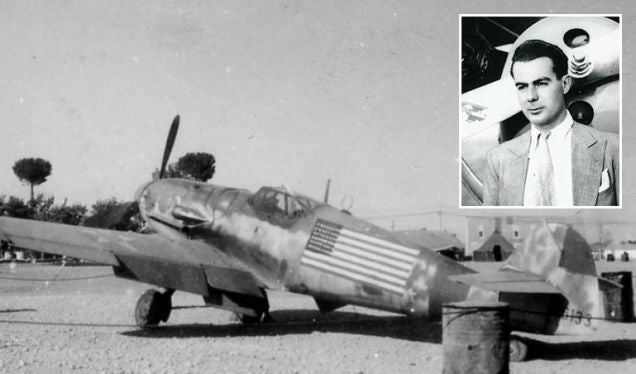
(Authors unknown)
May 26, 1958 – The death of Constantin “Bazu” Cantacuzino, a Romanian pilot and one of the highest scoring Romanian aces of WWII. Before the outbreak of WWII, Cantacuzino was an aerobatic pilot and chief pilot for the Romanian state airline LARES. With the start of the war, Romania sided with the Axis powers, and Cantacuzino fought both Soviet and Allied aircraft and claimed one of six !!!error: Indecipherable SUB-paragraph formatting!!! shot down during a bombing mission. But as the Axis powers began to falter near the close of the war, Romania switched allegiance to the Allied side, and Cantacuzino began to fight his former German allies, downing three !!!error: Indecipherable SUB-paragraph formatting!!! attacking Bucharest. But his most spectacular mission came when he was tasked with transporting the highest-ranking American POW in Romania, Lieutenant Colonel James Gunn III, to Italy. Flying a !!!error: Indecipherable SUB-paragraph formatting!!! emblazoned with an American flag, Cantacuzino landed in Italy to lead a flight of 56 !!!error: Indecipherable SUB-paragraph formatting!!! to return to Romania to repatriate the American POWs. When his Messerschmitt could not be refueled, he was given a !!!error: Indecipherable SUB-paragraph formatting!!! , which he mastered after only a single flight. Cantacuzino ended the war with 43 victories, and returned to work with LARES. However, all of his lands were confiscated by the Communist government, and he eventually escaped to Italy in 1947.
!!! UNKNOWN CONTENT TYPE !!!
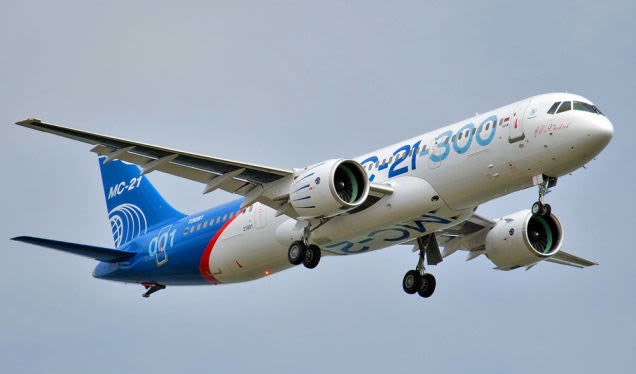 !!!CAPTION ERROR: MAY BE MULTI-LINE OR CONTAIN LINK!!!
!!!CAPTION ERROR: MAY BE MULTI-LINE OR CONTAIN LINK!!!
May 28, 2017 – The first flight of the Irkut MC-21,
a narrow-body twin-engine airliner developed by the
!!!error: Indecipherable SUB-paragraph formatting!!!
and produced by the
!!!error: Indecipherable SUB-paragraph formatting!!!
, a subsidiary of Russian state-owned
!!!error: Indecipherable SUB-paragraph formatting!!!
and the same company that produced the
!!!error: Indecipherable SUB-paragraph formatting!!!
family of multi-role fighters. Developed as a replacement for the aging
!!!error: Indecipherable SUB-paragraph formatting!!!
trijet, the MC-21 features a carbon fiber reinforced polymer wing and is powered by either
!!!error: Indecipherable SUB-paragraph formatting!!!
or
!!!error: Indecipherable SUB-paragraph formatting!!!
turbofan engines. Irkut plans to produce the airliner in two lengths that will accommodate up to 165 (MC-21-200) or 211 (MC-21-300) passengers in a single-class configuration, and touts its new airliner as being more efficient than its Boeing or Airbus counterparts. As of December 2018, Irkut has produced three flying prototypes with four more aircraft under assembly, and the company plans to have the airliner in service by 2020.
!!! UNKNOWN CONTENT TYPE !!!
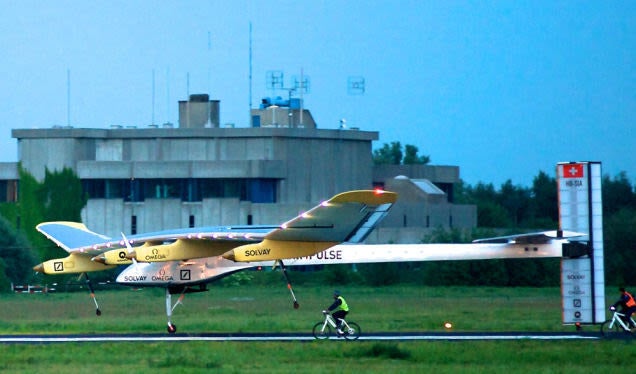 !!!CAPTION ERROR: MAY BE MULTI-LINE OR CONTAIN LINK!!!
!!!CAPTION ERROR: MAY BE MULTI-LINE OR CONTAIN LINK!!!
May 28, 2010 – The Solar Impulse 1 makes its first flight powered by solar energy. !!!error: Indecipherable SUB-paragraph formatting!!! (HB-SIA) is a long-range, experimental aircraft developed to demonstrate the viability of solar power for extended flight and designed to promote clean technologies. Following an 87-minute flight on April 2, 2010, Solar Impulse 1 made its first entirely-solar powered flight, with the aircraft’s batteries charged during the flight. Solar Impulse 1 was followed by Solar Impulse 2, which carries more solar cells and a more powerful engine. Flying Solar Impulse 2, pilots André Borschenberg and Bertand Piccard departed from Abu Dhabi in March of 2015 and successfully completed a circumnavigation of the globe on July 13, 2016 using only solar power.
!!! UNKNOWN CONTENT TYPE !!!
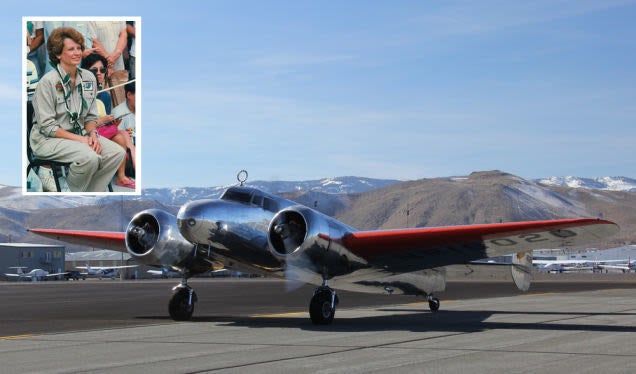 !!!CAPTION ERROR: MAY BE MULTI-LINE OR CONTAIN LINK!!!
!!!CAPTION ERROR: MAY BE MULTI-LINE OR CONTAIN LINK!!!
May 28, 1997 – Linda Finch completes a recreation of Amelia Earhart’s attempt to circumnavigate the globe . Finch, an aviatrix and businesswoman from San Antonio, TX, took off on March 17 in a restored 1935 !!!error: Indecipherable SUB-paragraph formatting!!! that had been prepared identically to Earhart’s plane. Her flight took 10 weeks to complete flying legs of 8 to 18 hours at a time and stopping at 36 different locations in 18 countries. The flight covered approximately 26,000 miles. After completing the circumnavigation, Finch’s Electra was acquired by the !!!error: Indecipherable SUB-paragraph formatting!!! in Seattle, Washington where it will be displayed.
(Note: The date Finch began her flight, March 17, is the departure date for Earhart’s first attempt at circumnavigating the globe which ended in Hawaii following a takeoff accident. The second attempt, in which Earhart and copilot Fred Noonan disappeared, was begun on July 2, 1937.)
!!! UNKNOWN CONTENT TYPE !!!
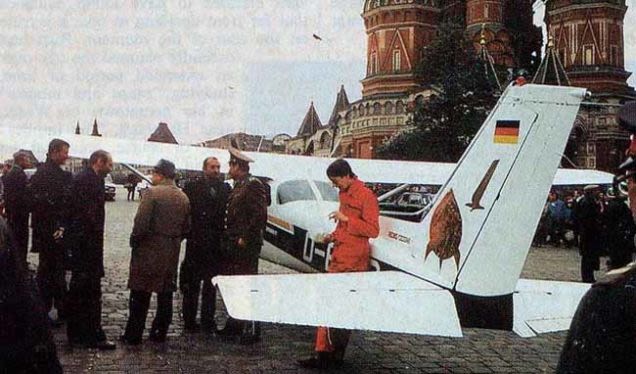 !!!CAPTION ERROR: MAY BE MULTI-LINE OR CONTAIN LINK!!!
!!!CAPTION ERROR: MAY BE MULTI-LINE OR CONTAIN LINK!!!
May 28, 1987 – Mathias Rust lands in Red Square. !!!error: Indecipherable SUB-paragraph formatting!!! , an 18-year-old aviator from West Germany with only 50 hours of flying time, hoped to hasten the end of the !!!error: Indecipherable SUB-paragraph formatting!!! by creating what he called an “imaginary bridge” between East and West. The inexperienced Rust departed from Hamburg on May 13 in a !!!error: Indecipherable SUB-paragraph formatting!!! modified to carry extra fuel and flew first to the Faroe Islands, then to Norway and Finland. When he departed Helsinki on May 28, Rust told air traffic controllers he planned to fly to Stockholm, but then deactivated the Cessna’s transponder and turned toward Moscow. Rust’s plane was detected on Russian radars, fighters were scrambled and surface-to-air missiles were targeted, but confusion among the Russian air defenses allowed Rust to fly unmolested until he landed his Cessna on a bridge and taxied into the middle of !!!error: Indecipherable SUB-paragraph formatting!!! . In a way, Rust’s plan to help bring an end to the Cold War was successful, as the veneer of invincibility had been removed from the Russian military, and many of the old, entrenched Russian officers who bungled the interception of Rust’s plane were ousted by General Secretary !!!error: Indecipherable SUB-paragraph formatting!!! , helping to pave the way for reforms that ultimately led to the dissolution of the Soviet Union in 1991.
!!! UNKNOWN CONTENT TYPE !!!
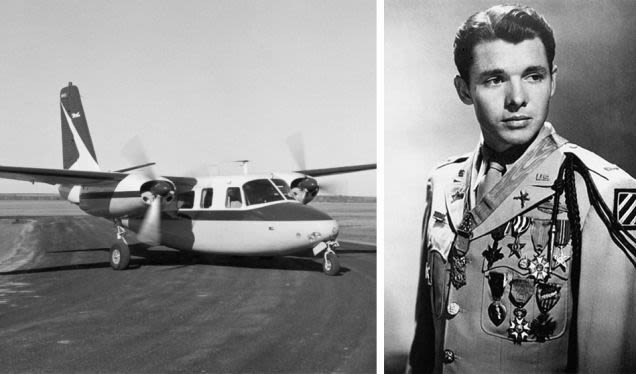 !!!CAPTION ERROR: MAY BE MULTI-LINE OR CONTAIN LINK!!!
!!!CAPTION ERROR: MAY BE MULTI-LINE OR CONTAIN LINK!!!
May 28, 1971 – Audie Murphy is killed in a plane crash.
Murphy was one of the most highly decorated American service members in WWII, receiving
!!!error: Indecipherable SUB-paragraph formatting!!!
from the US Army, as well as awards from the French and Belgian governments for his heroism in combat. Following the war, Murphy enjoyed a successful acting career, and documented his wartime exploits in the 1955 film
!!!error: Indecipherable SUB-paragraph formatting!!!
. On the night of his death, Murphy was a passenger in an
!!!error: Indecipherable SUB-paragraph formatting!!!
as the plane flew through rain and fog with zero visibility. The pilot, though experienced, was not rated for instrument flying, and was unfamiliar with the aircraft type. Murphy’s plane crashed near Roanoke, Virginia, and the National Transportation Safety Board concluded that the pilot’s decision to continue flying under
!!!error: Indecipherable SUB-paragraph formatting!!!
(VFR) in
!!!error: Indecipherable SUB-paragraph formatting!!!
(IMC) led to the crash.
!!! UNKNOWN CONTENT TYPE !!!
Connecting Flights
!!! UNKNOWN CONTENT TYPE !!!
!!! UNKNOWN CONTENT TYPE !!!
!!! UNKNOWN CONTENT TYPE !!!
!!! UNKNOWN CONTENT TYPE !!!
!!! UNKNOWN CONTENT TYPE !!!
If you enjoy these Aviation History posts, please let me know in the comments. And if you missed any of the past articles, you can find them all at
!!!error: Indecipherable SUB-paragraph formatting!!!
. You can also find more stories about aviation, aviators and airplane oddities at
!!!error: Indecipherable SUB-paragraph formatting!!!
.
!!! UNKNOWN CONTENT TYPE !!!
 Ash78, voting early and often
> ttyymmnn
Ash78, voting early and often
> ttyymmnn
05/28/2019 at 12:50 |
|
developed into an electronic warfare variant known as the F-4G Wild Weasel
I just had to quote this so people will click it. This is truly one of those “HOW ABOUT NO?” jobs in the Air Force.
tl;dr:
In brief, the task of a Wild Weasel aircraft is to bait enemy anti-aircraft defenses into targeting it with their radars, whereupon the radar waves are traced back to their source, allowing the Weasel or its teammates to precisely target it for destruction. A simple analogy is playing the game of “ flashlight tag ” in the dark; a flashlight is usually the only reliable means of identifying someone in order to “tag” (destroy) them, but the light immediately renders the bearer able to be identified and attacked as well. The result is a hectic game of cat-and-mouse in which the radar “flashlights” are rapidly cycled on and off in an attempt to identify and kill the target before the target is able to home in on the emitted radar “light” and destroy the site.
 f86sabre
> ttyymmnn
f86sabre
> ttyymmnn
05/28/2019 at 13:03 |
|
Busy week! Would have been cool to see the F-100 with the T-Birds.
 Future next gen S2000 owner
> ttyymmnn
Future next gen S2000 owner
> ttyymmnn
05/28/2019 at 13:18 |
|
F-4 Phantom is the best plane ever.
 ttyymmnn
> f86sabre
ttyymmnn
> f86sabre
05/28/2019 at 13:21 |
|
It seems like this gig is either feast or famine. Some of these posts are coming in over 4k words.
 user314
> Ash78, voting early and often
user314
> Ash78, voting early and often
05/28/2019 at 13:22 |
|
Hence the Wild Weasel patch:

The letters at the bottom stand for “You gotta be shitting me.”
 ttyymmnn
> Ash78, voting early and often
ttyymmnn
> Ash78, voting early and often
05/28/2019 at 13:30 |
|
https://www.historynet.com/vietnams-wild-weasels.htm
One of the new weasels, EWO Captain Jack Donovan, summed up the feelings of all the Weasels about their new mission, when he said, “ You want me to fly in the back of a little tiny fighter aircraft with a crazy fighter pilot who thinks he’s invincible, home in on a SAM site in North Vietnam, and shoot it before it shoots me, you gotta be shittin me!”
https://www.militaryhistoryonline.com/vietnam/airpower/wildweasel.aspx
 TheRealBicycleBuck
> Ash78, voting early and often
TheRealBicycleBuck
> Ash78, voting early and often
05/28/2019 at 13:35 |
|
When I was teaching, I had the good fortune to have a former soldier in my class. When we started the segment on GPS, he told the story of how Iraq was using GPS jammers to interrupt the GPS signal, making it hard to navigate and drop smart bombs. What they didn’t realize is that the U.S. can use the jamming signal as a beacon to guide bombs straight to the source.
 TheRealBicycleBuck
> ttyymmnn
TheRealBicycleBuck
> ttyymmnn
05/28/2019 at 13:41 |
|
It seems I ha ve a thing for fork-tailed planes. My favorites include the P-38 Lightning, the Black Widow, and the Skymaster. The F-4 and the F-16 were also among my favorites, especially after an Airman gave me models of each when I was a little kid.
 ttyymmnn
> TheRealBicycleBuck
ttyymmnn
> TheRealBicycleBuck
05/28/2019 at 13:58 |
|
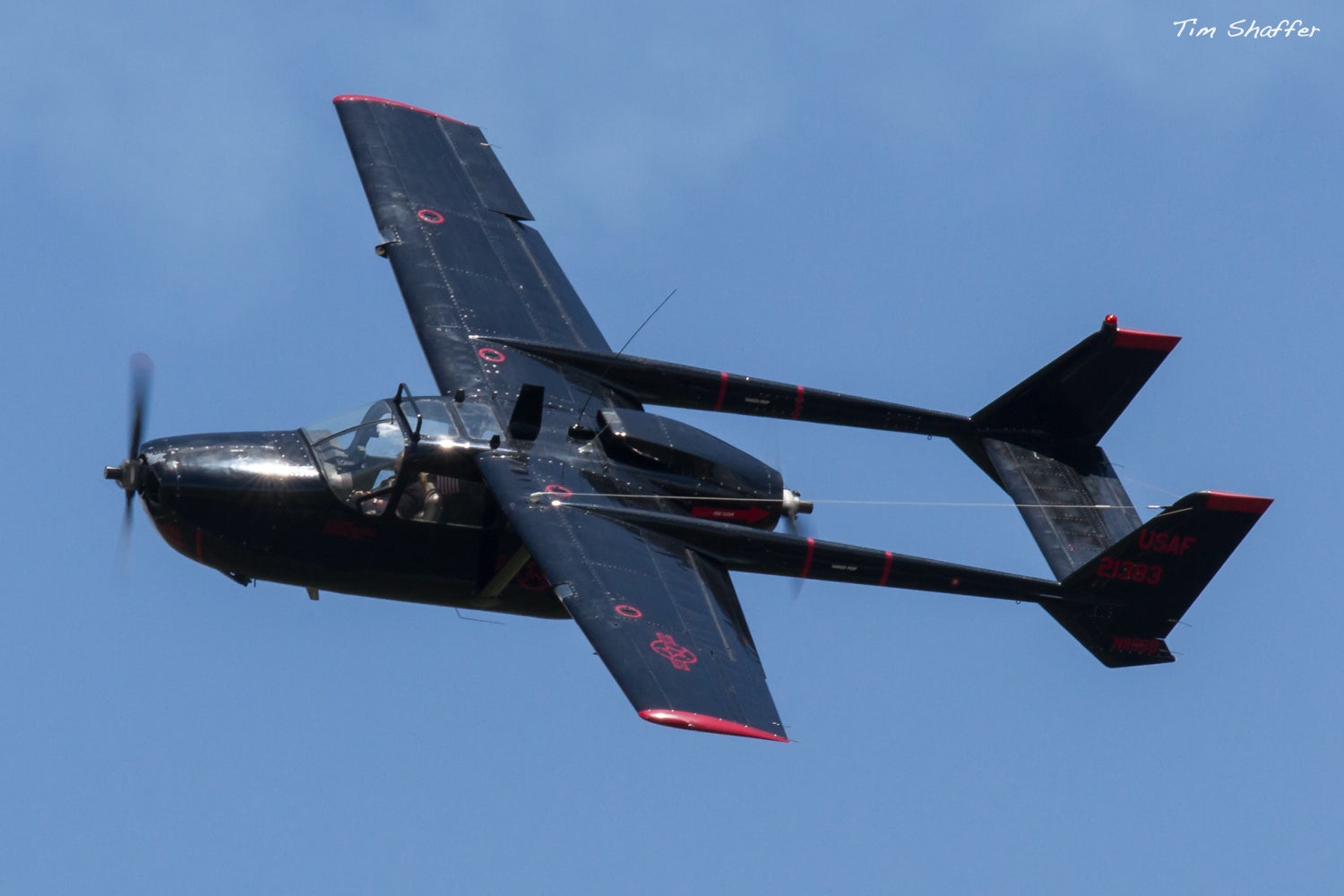
From the show at TPL a couple of weeks ago. As far as push-pull goes, my personal favorite has always been the Pfeil .
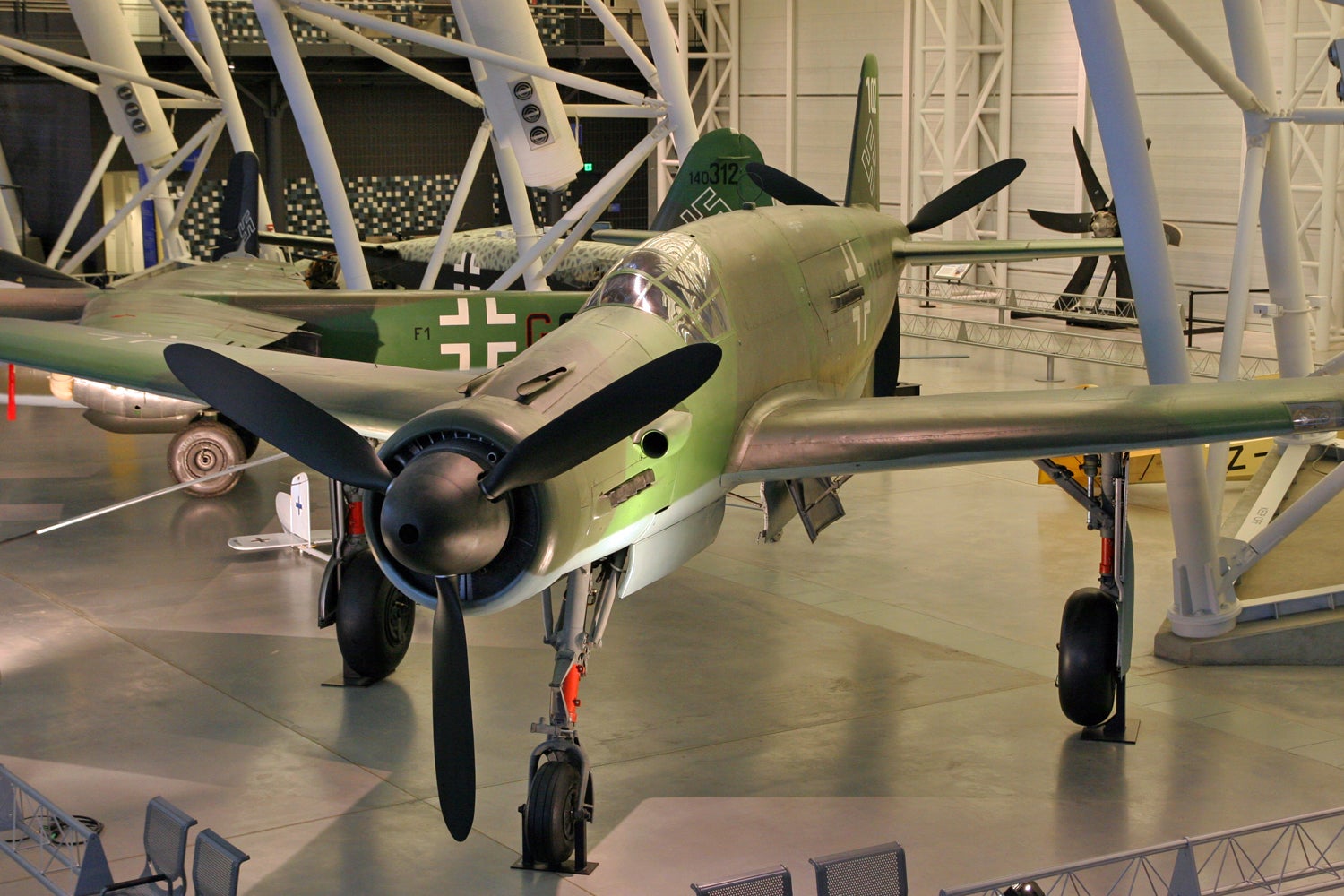
 user314
> ttyymmnn
user314
> ttyymmnn
05/28/2019 at 14:07 |
|
From the (P-61) B model forward, the upper turret was removed.
I don’t think that’s entirely accurate:
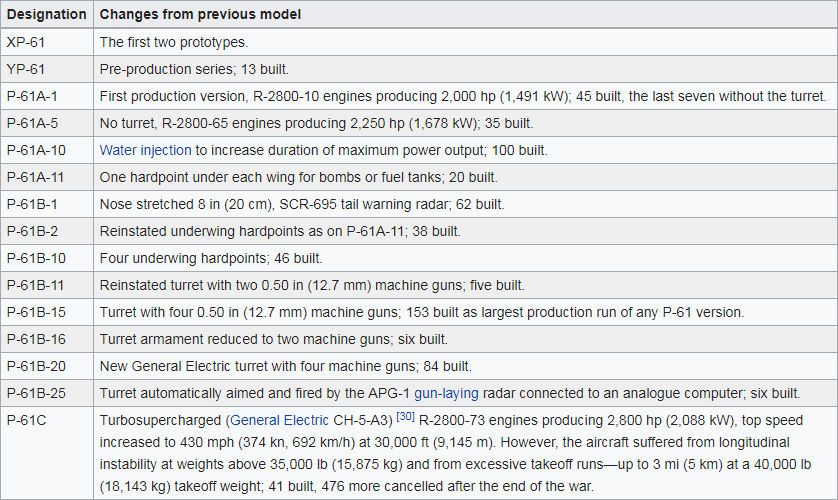
The A models Blocks 5 through 11 and B models Blocks 1 through 10 lacked the turret, but B models Blocks 15, 16, 20 and 25 all had turrets of varying types. The turret was removed again for the C model, but there were only 41 built.
 TheRealBicycleBuck
> ttyymmnn
TheRealBicycleBuck
> ttyymmnn
05/28/2019 at 14:07 |
|
I’ve never seen a Pfiel. It looks interesting, but it lacks the cool twin boom design.
 user314
> ttyymmnn
user314
> ttyymmnn
05/28/2019 at 14:14 |
|
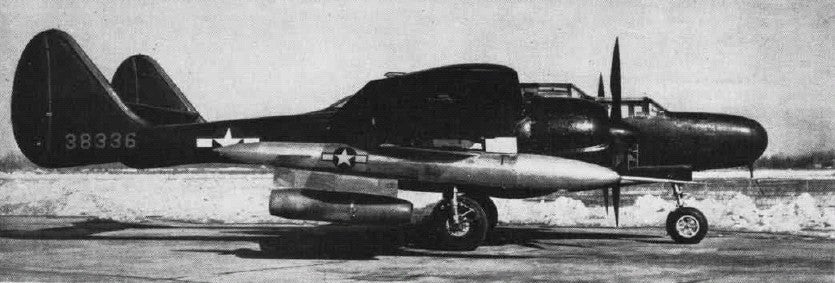
An ex-USAAF P-61, bailed to the USMC and re-designated F2T, was used in the Gorgon IV ASM test program. Originally begun during WWII, the Gorgon was originally designated KUM-1 , then PTV-2 before finally being redesignated PTV-N-2, and were designed to be partially radar-guided and partially controlled from the launch aircraft .
 ttyymmnn
> TheRealBicycleBuck
ttyymmnn
> TheRealBicycleBuck
05/28/2019 at 14:14 |
|
It does lack the twin boom. How about the Fw 189 ?
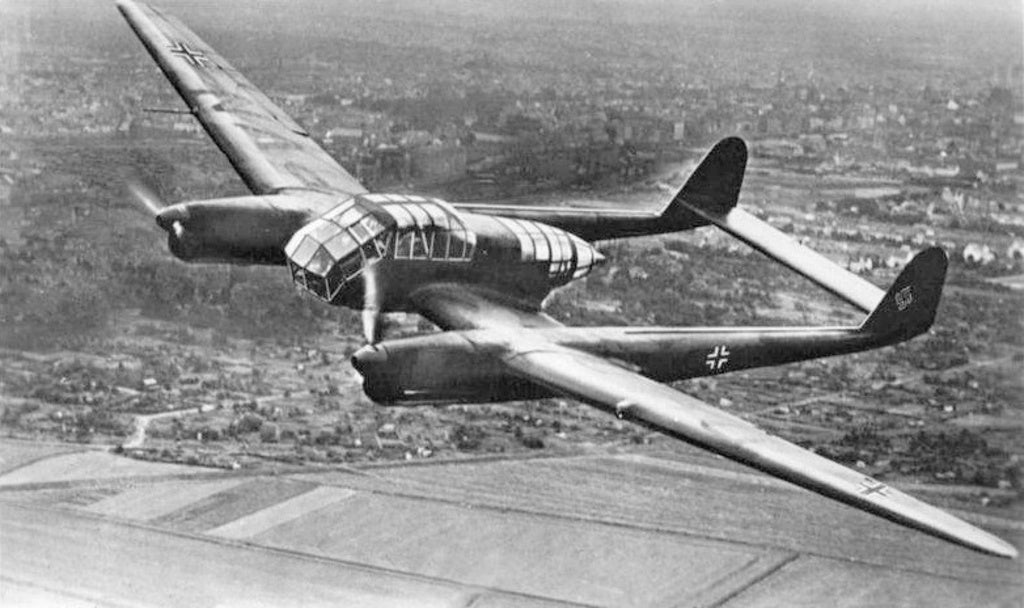
 ttyymmnn
> user314
ttyymmnn
> user314
05/28/2019 at 14:15 |
|
“Gorgon” may be the coolest missile name ever.
 user314
> ttyymmnn
user314
> ttyymmnn
05/28/2019 at 14:20 |
|
I’d go with Harpoon m’self.
 MattHurting
> ttyymmnn
MattHurting
> ttyymmnn
05/28/2019 at 14:22 |
|
Unrelated to the story, but the US Air Force Academy graduation ceremony is this Thursday, which means the Thunderbirds are practicing in town. As my house overlooks the Academy, we get a quality viewing party every year. And, I work down near Peterson AFB, so we hear them down here too.
 ttyymmnn
> MattHurting
ttyymmnn
> MattHurting
05/28/2019 at 14:29 |
|
We drove past USAFA last summer on the way home from South Dakota. Of course, being a plane junkie, I had to stop at the interstate overlook and snap some pictures of America’s future class of AF pilots .
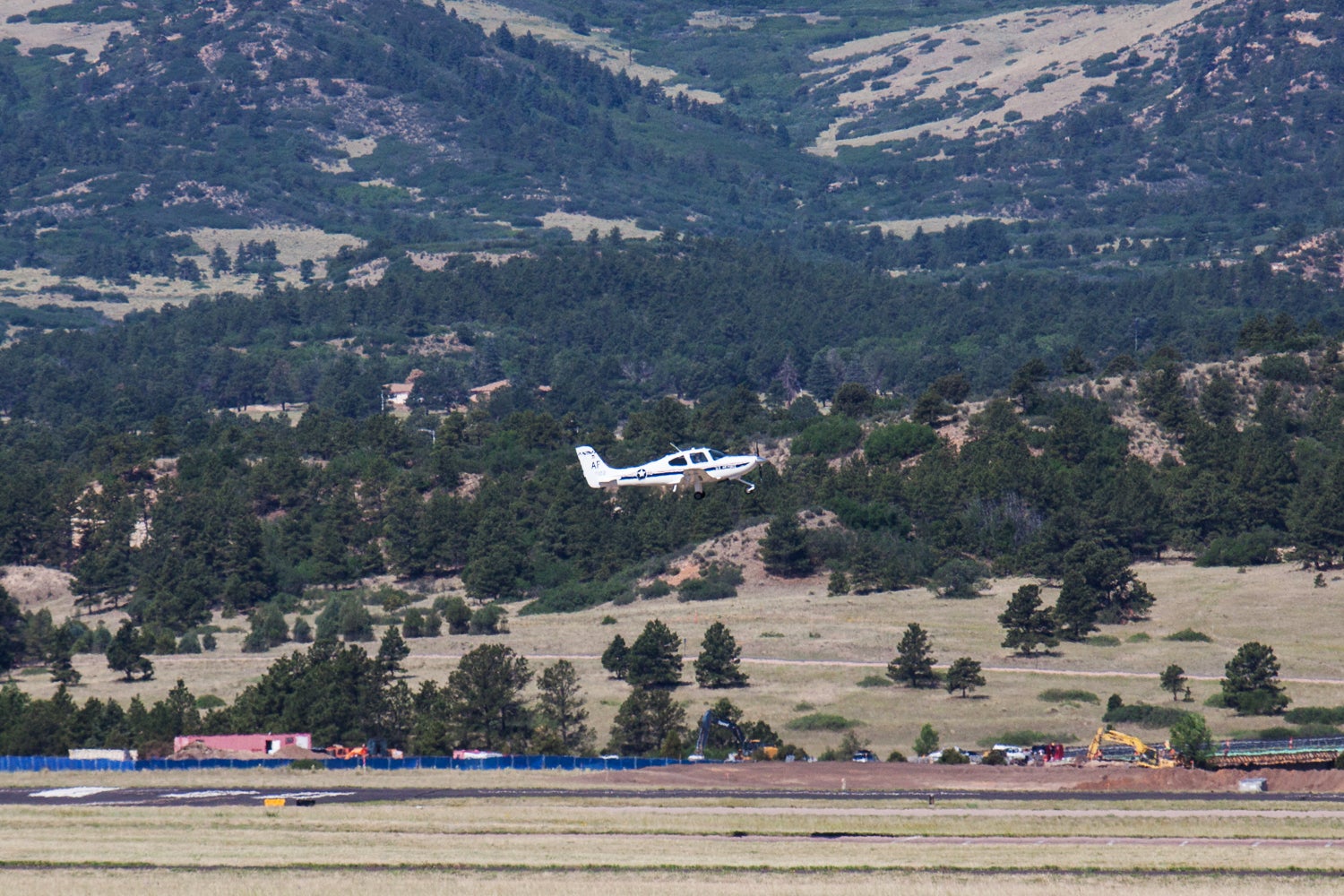
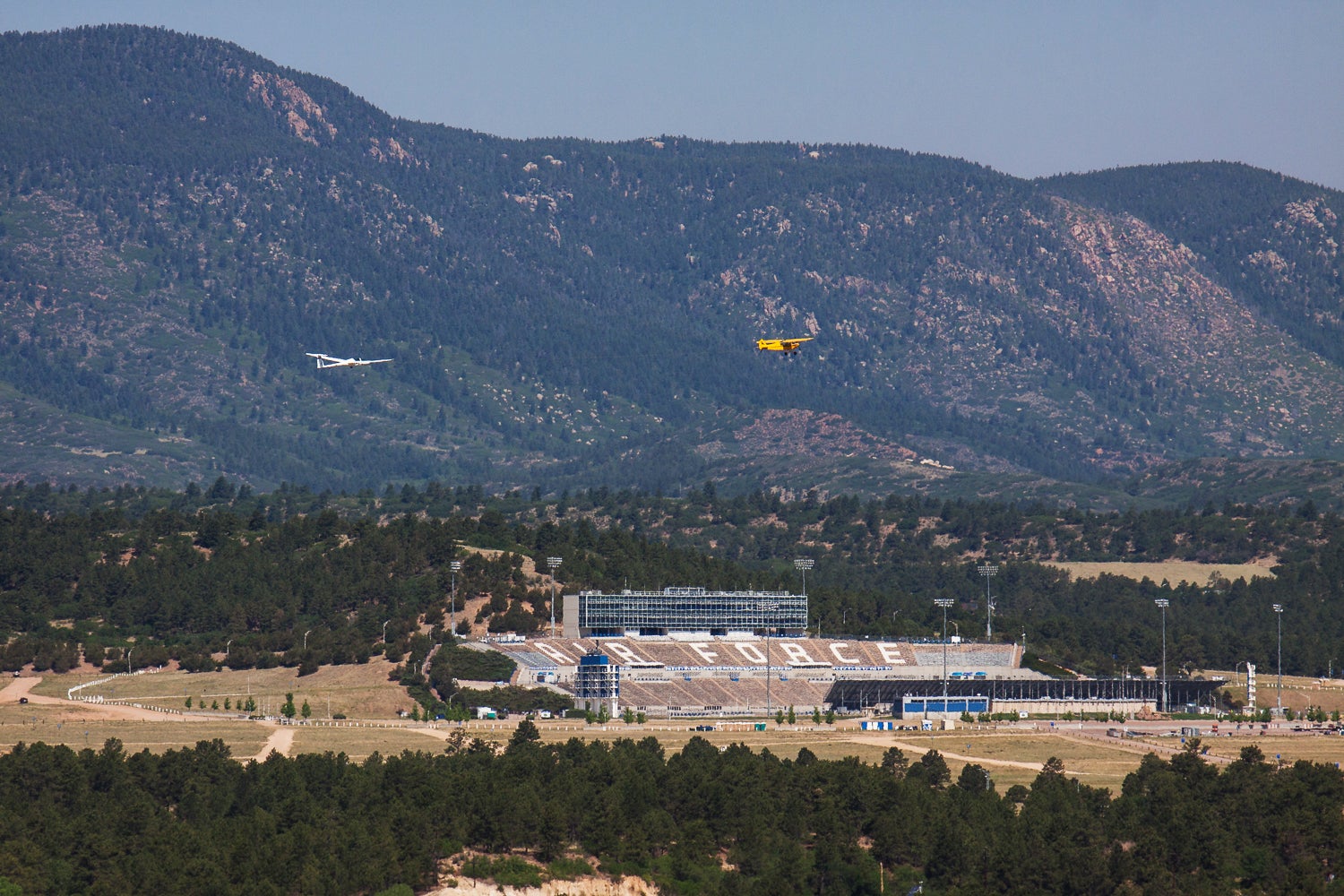
 user314
> Future next gen S2000 owner
user314
> Future next gen S2000 owner
05/28/2019 at 14:40 |
|
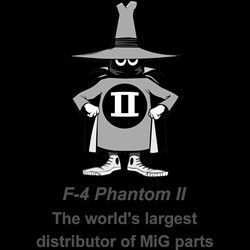
 MattHurting
> ttyymmnn
MattHurting
> ttyymmnn
05/28/2019 at 14:40 |
|
Strangely enough, there are several hikes out this way that lead to wreckage from a plane crash. Probably most notably a B-24 that went down just west of Colorado Springs on April 26, 1944.
 TheRealBicycleBuck
> ttyymmnn
TheRealBicycleBuck
> ttyymmnn
05/28/2019 at 14:44 |
|
If it doesn’t look like a blade failure would chop the pilot in half, then the proportions are just wrong....
 ttyymmnn
> MattHurting
ttyymmnn
> MattHurting
05/28/2019 at 15:13 |
|
I would be interested to see that.
 BaconSandwich is tasty.
> ttyymmnn
BaconSandwich is tasty.
> ttyymmnn
05/28/2019 at 23:23 |
|
It never occurred to me that the F-4 was a two person aircraft. I always pictured it as being much smaller.
 ttyymmnn
> BaconSandwich is tasty.
ttyymmnn
> BaconSandwich is tasty.
05/28/2019 at 23:27 |
|
The F-4 is damned big, and was always a two-person aircraft. You get a little sense of the size in these shots I took at an air show a few years ago, the only time I’ve seen a Phantom at a show. Check out how small the pilot looks.
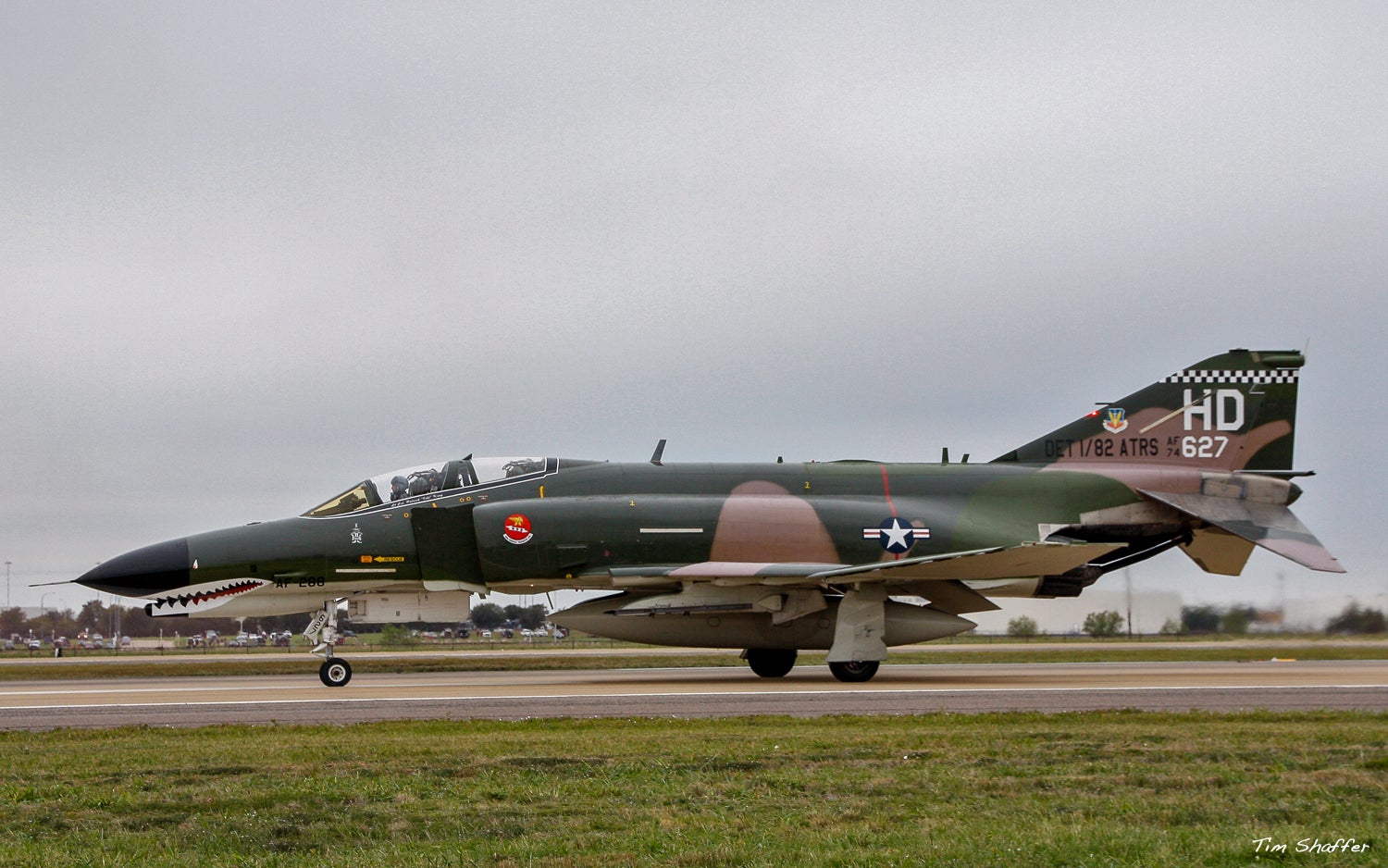
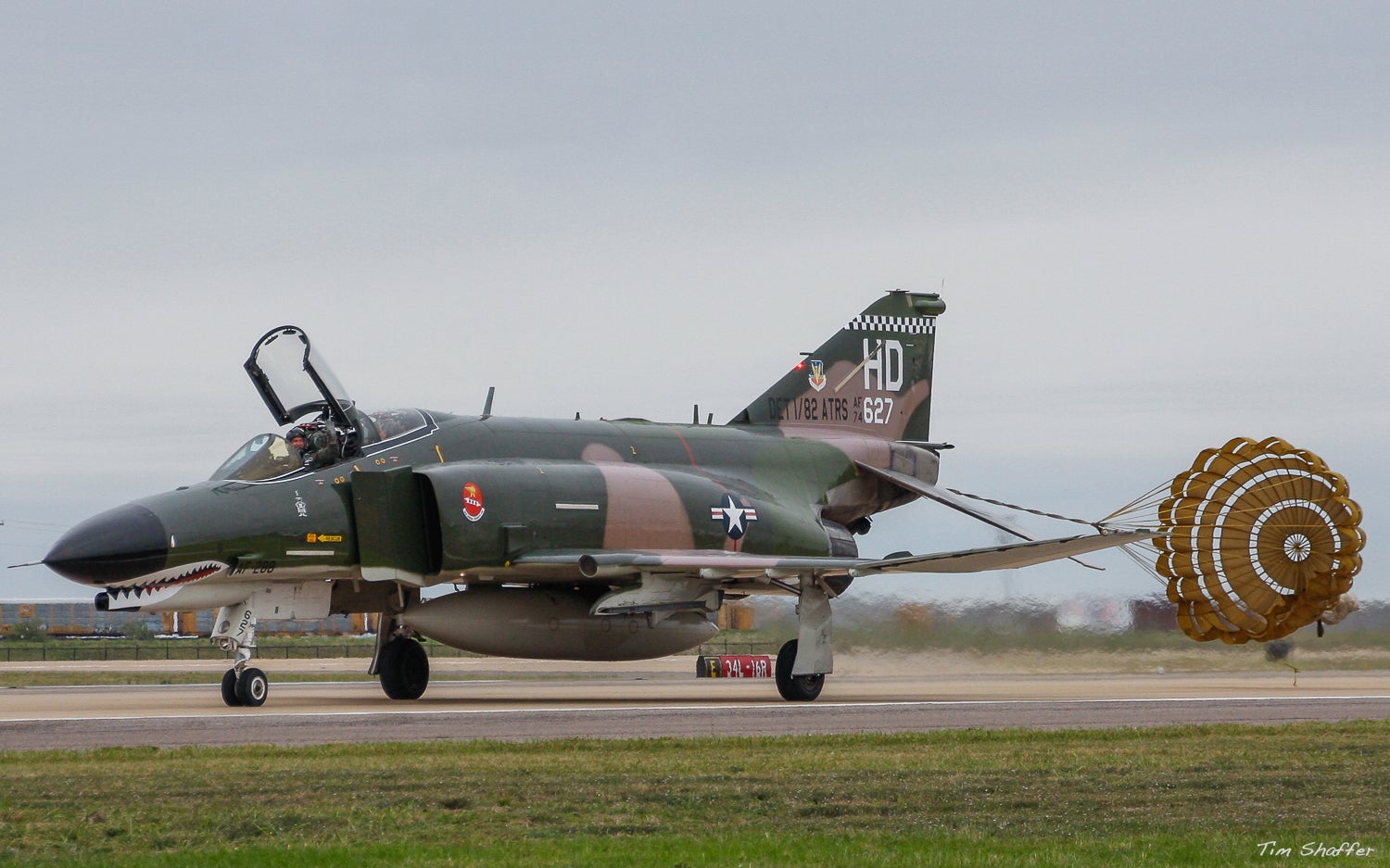
 ttyymmnn
> TheRealBicycleBuck
ttyymmnn
> TheRealBicycleBuck
05/28/2019 at 23:36 |
|
How about the XP-58 Chain Lightning ?
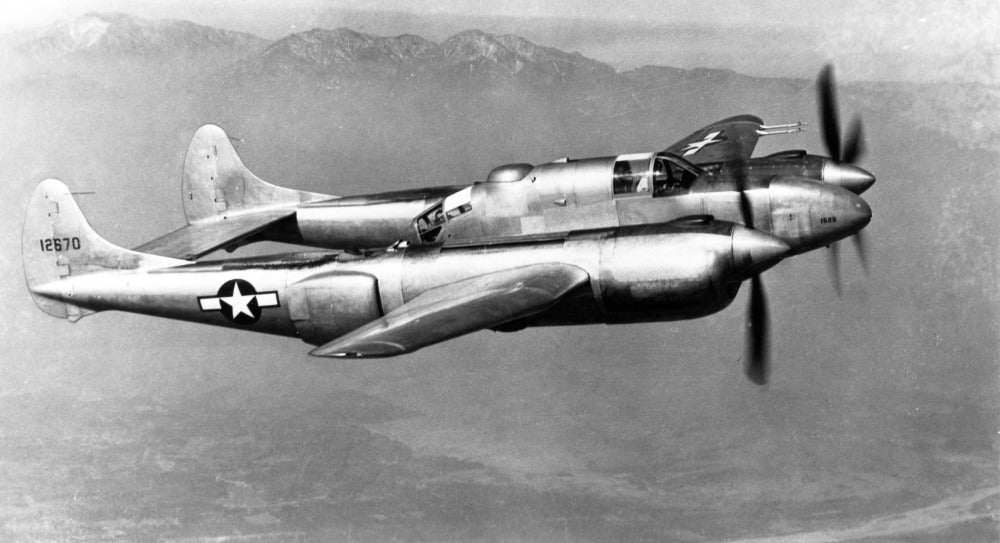
Or the Swoose Goose ?
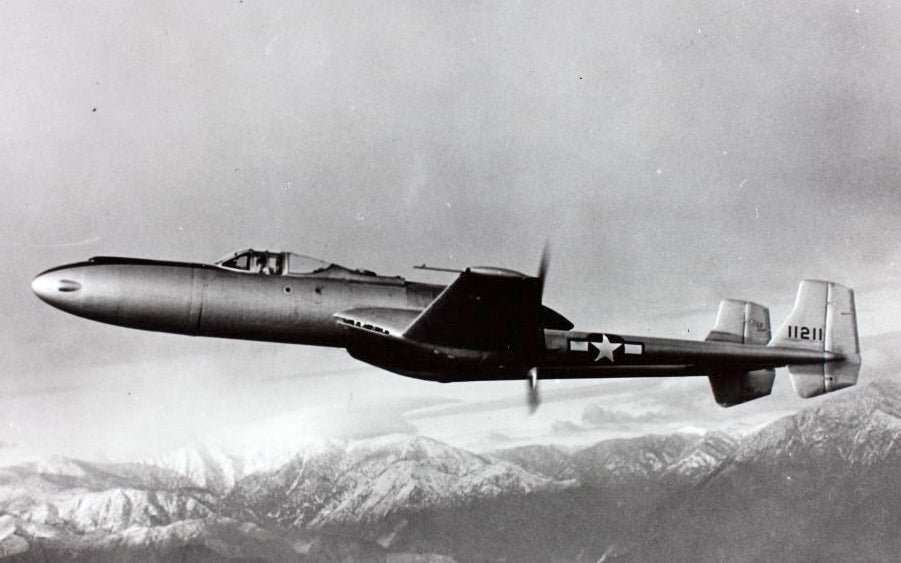
I’ve actually written about both of these twin boomers.
https://oppositelock.kinja.com/the-lockheed-xp-58-chain-lightning-lightning-never-str-1797304715
https://oppositelock.kinja.com/vultee-xp-54-swoose-goose-1707422314
 BaconSandwich is tasty.
> ttyymmnn
BaconSandwich is tasty.
> ttyymmnn
05/28/2019 at 23:49 |
|
I guess in my childhood brain, it was relative to the size of of the toy aircraft that I had.
 Ash78, voting early and often
> BaconSandwich is tasty.
Ash78, voting early and often
> BaconSandwich is tasty.
05/29/2019 at 00:01 |
|
Yep, it was a beast. Just like the F-14 that semi-replaced it for the Navy.
 Ash78, voting early and often
> ttyymmnn
Ash78, voting early and often
> ttyymmnn
05/29/2019 at 00:05 |
|
Here’s another interesting one — a B-24 that crashed into Mt Humphreys, AZ (between Flagstaff and the Grand Canyon) in 1944. I went looking for it once but ran out of time...it’s pretty well off the trail.
 TheRealBicycleBuck
> ttyymmnn
TheRealBicycleBuck
> ttyymmnn
05/29/2019 at 00:18 |
|
Chain lightning? Yes.
Swoose Goose? You’re joking, right?
 ttyymmnn
> TheRealBicycleBuck
ttyymmnn
> TheRealBicycleBuck
05/29/2019 at 00:50 |
|
Well, it’s got twin booms. How about the Hughes XF-11, the plane that damn near killed Howard Hughes? To be fair to the XF-11, Hughes almost killed himself in it because he didn’t know what he was doing.
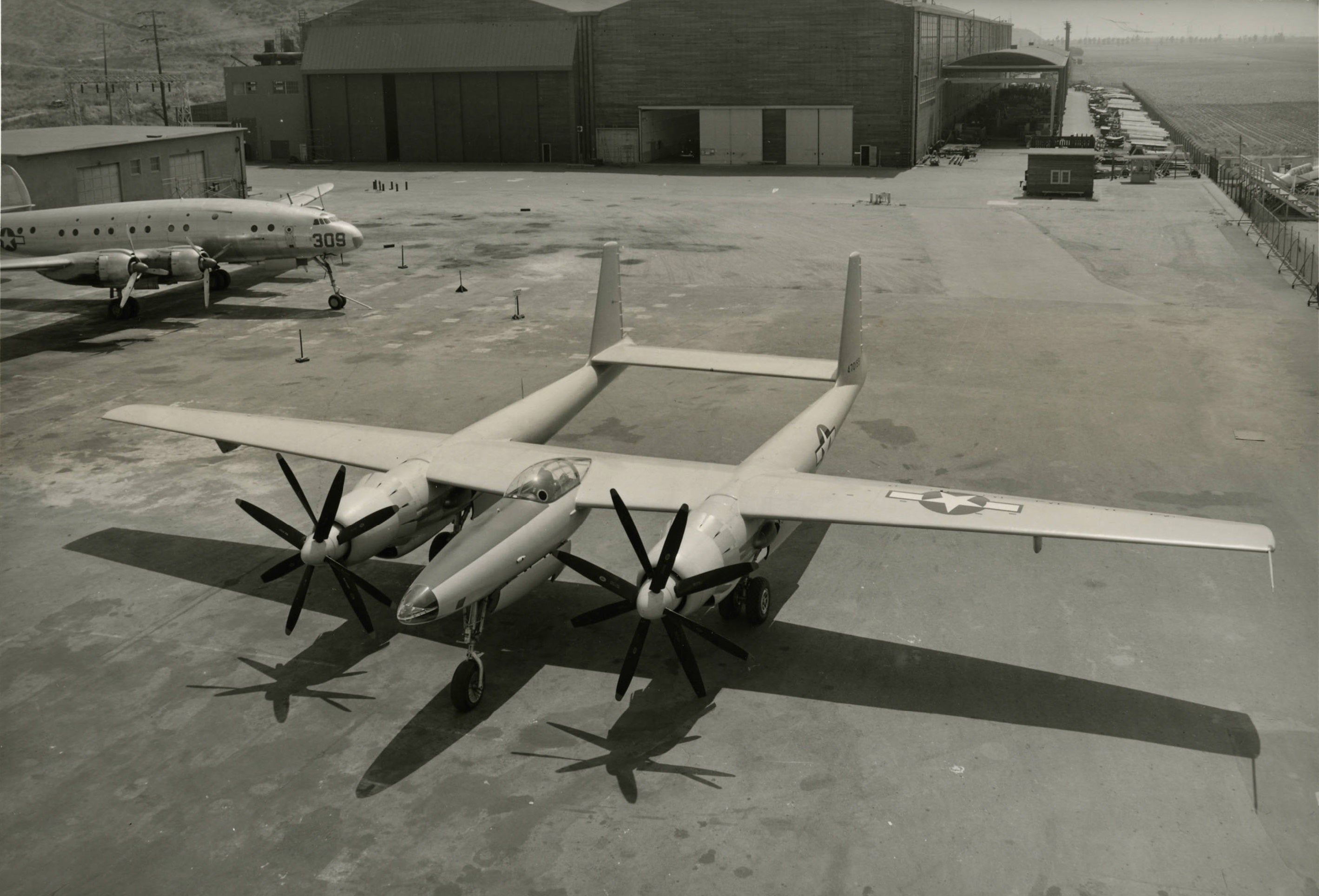
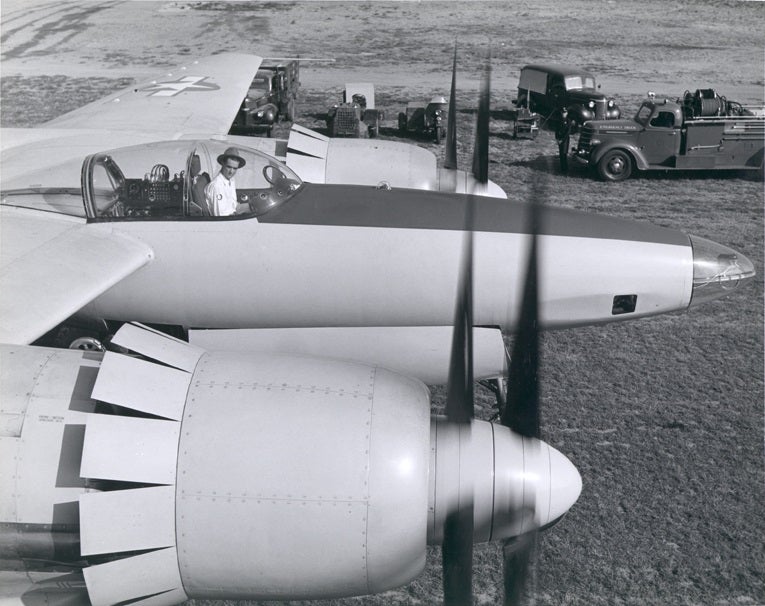
Howard Hughes did nothing small.
 TheRealBicycleBuck
> ttyymmnn
TheRealBicycleBuck
> ttyymmnn
05/29/2019 at 01:20 |
|
Twin boom, twin engine, and CONTRA-ROTATING PROPS!!!
Yeah, that’s a win.
 john28ryr88
> ttyymmnn
john28ryr88
> ttyymmnn
05/29/2019 at 14:13 |
|
finally made it to Wright-Patterson on Monday and got to see some of these up close (sorry for crappy cell phone pics).
Woke up Tuesday morning to the news of the tornadoes in Akron and feared the worst. luckily the museum was relatively unscathed...
 ttyymmnn
> john28ryr88
ttyymmnn
> john28ryr88
05/29/2019 at 14:18 |
|
Former Foxtrot Alpha columnist Tyler Rogoway has a write up about the tornadoes over at The War Zone. It was a close shave for the museum, but I had to remind myself that the lives of those people living in Dayton are more important, even considering my love of aviation.
That said, the USAF Museum is an absolutely extraordinary place. My son and I went last summer and got there when it opened and left as they locked the doors behind us. I could have spent a week there. Seeing so many of the aircraft that I have written about was a blast. And the new fourth hangar is amazing. I was there about 20 years ago and you had to take a bus to a remote location to see the Valkyrie, so I didn’t get to see it then. I’ve got an album of photos from last summer if you’d like to check them out.
https://tshaff.smugmug.com/Aviation/US-Air-Force-Museum/